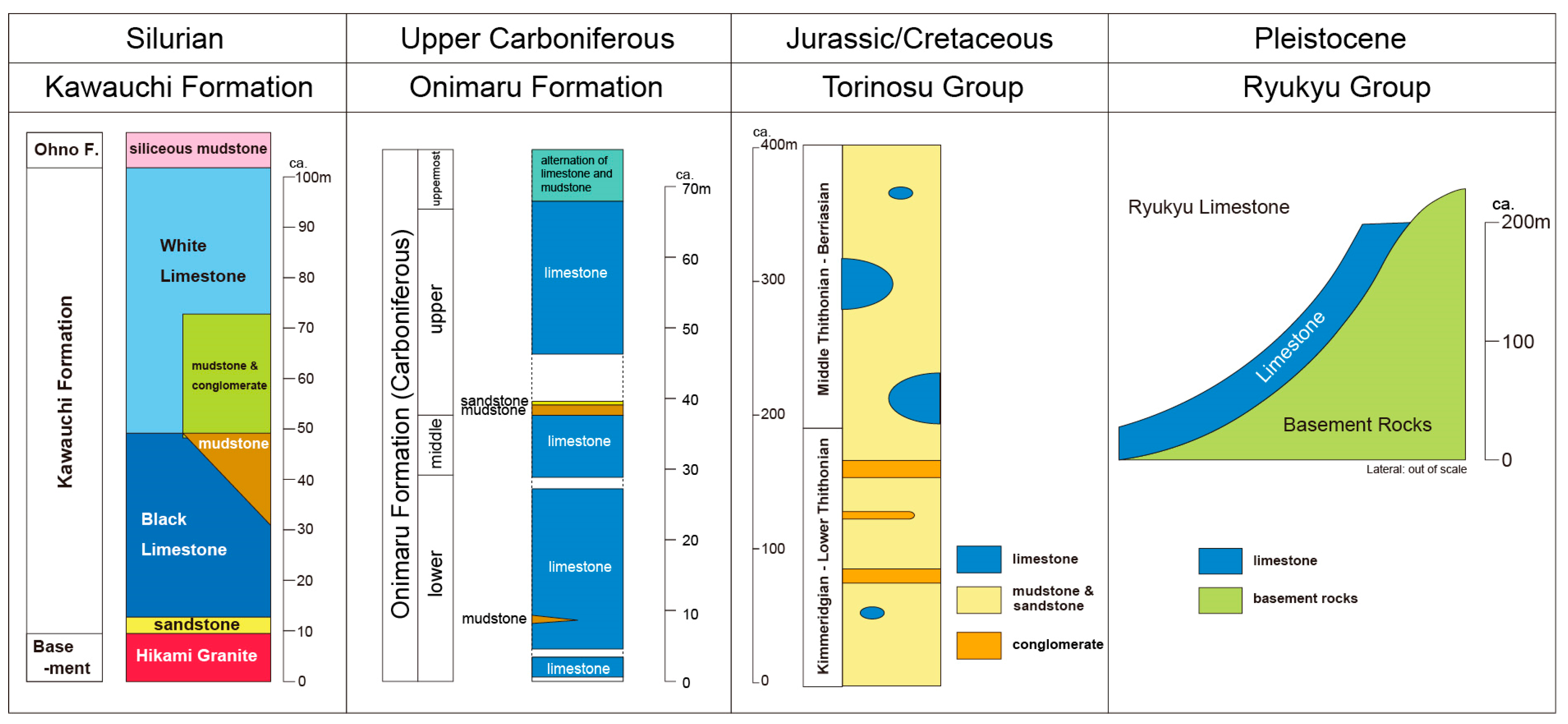Geological and Geographical Characteristics of Limestone and Karst Landforms in Japan: Insights from Akiyoshidai, Seiyo (Shikoku), and Okinoerabu Island
Abstract
1. Introduction
- How can limestones in Japan be systematically classified in terms of their tectonic and depositional settings?
- In what ways do these limestones and their associated karst landscapes differ from those formed on continental shelves worldwide?
- What do these differences imply for understanding the geological evolution of the Japanese Islands and for global comparisons of carbonate systems?
2. Methodology
3. Results 1: Major Limestone Types in Japan
3.1. Proposal of New Terms on Limestone Classification Based on the Depositional Position and Environment
3.2. Geological Characteristics of Limestone in Japan
3.3. Accreted Oceanic Reef (AOR) Limestones
3.3.1. AOR Limestones in the Permian Accretionary Complex: 1. Akiyoshi Limestone
3.3.2. AOR Limestones in the Permian Accretionary Complex: 2. Shikoku Karst
3.3.3. AOR Limestones in the Jurassic Accretionary Complex
3.3.4. AOR Limestones in the Earliest Cretaceous Accretionary Complex
3.4. Autochthonous Arc-Shelf (AAS) Limestone
3.4.1. Paleozoic AAS Limestones
3.4.2. Mesozoic AAS Limestones
3.4.3. Cenozoic AAS Limestones
3.5. Uplift and Exhumation of Limestone
4. Results 2: Major Karst Landforms and Caves in Japan
4.1. Karst Landforms and Caves on the AOR Limestone 1: Akiyoshidai Karst Plateau
4.1.1. Akiyoshidai Karst Plateau Landforms
4.1.2. Akiyoshido Cave
4.1.3. Taishodo Cave
4.1.4. Kagekiyo-Ana Cave
4.1.5. Karst Development in Akiyoshidai
4.2. Karst Landforms and Caves on the AOR Limestone 2: Shikoku Karst and Rakan-Ana Cave
Rakan-Ana Cave
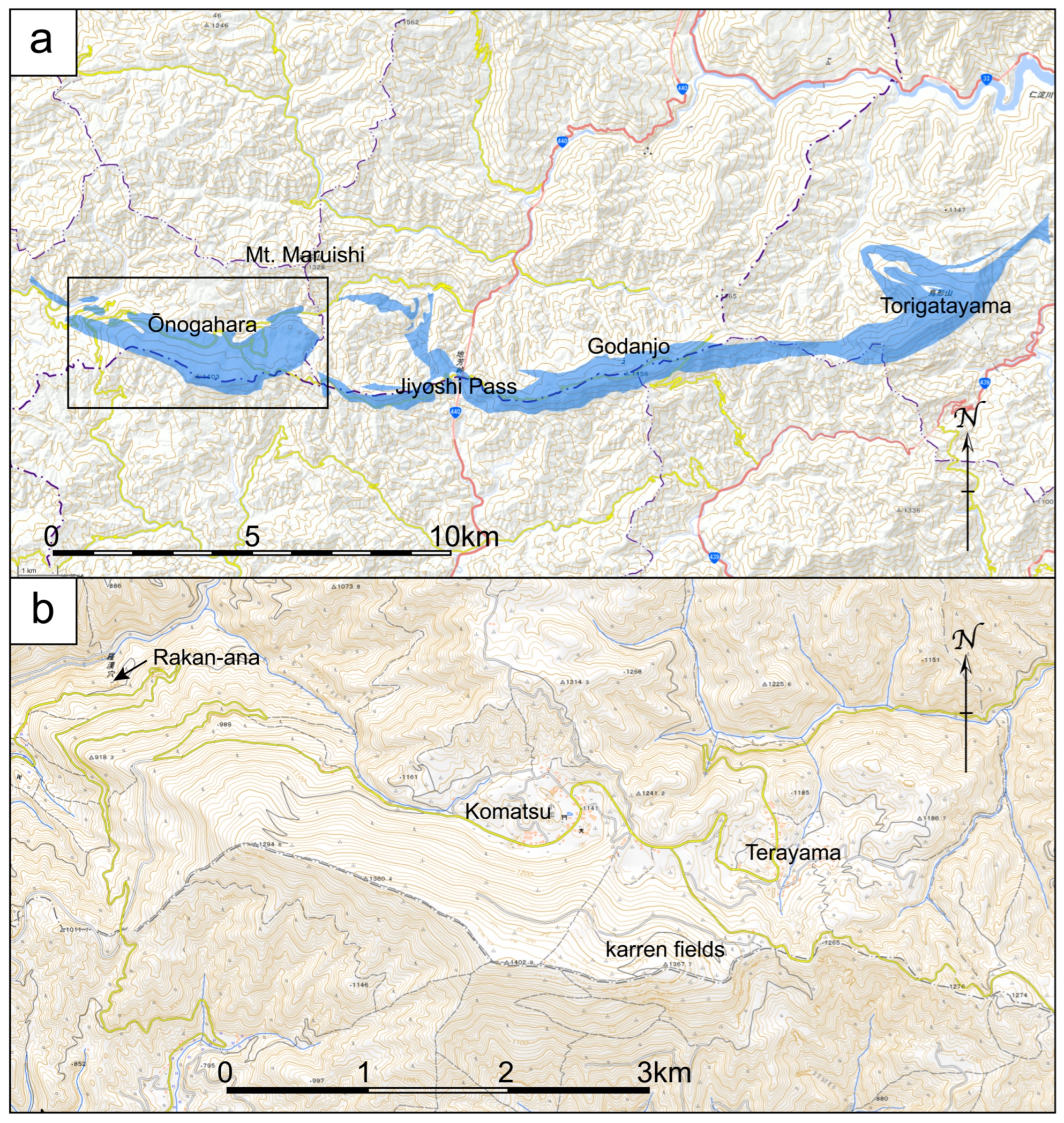
4.3. Representative Karst Landforms and Caves on the AAS Limestone 1: Torinosu Limestones
4.3.1. Anagami Cave
4.3.2. Nakatsu-Gawa Tufa
4.3.3. Kuranuki-Shiraishi Cave
4.3.4. Karst Development in the Torinosu Limestone, Seiyo (Shikoku)
4.4. Representative Karst Landforms and Caves on the AAS Limestone 2: Pleistocene Ryukyu Limestone on the Okinoerabu Island
4.4.1. Shoryu-Do Cave
4.4.2. Hakuho-Do Cave
4.4.3. Ginsui-Do Cave
4.4.4. Karst Development in Okinoerabu Island
4.5. Comparison of Karst Development in Representative Limestones in Japan
5. Discussion
5.1. Formation History of Three Major AOR Limestones on the Oceanic Plate
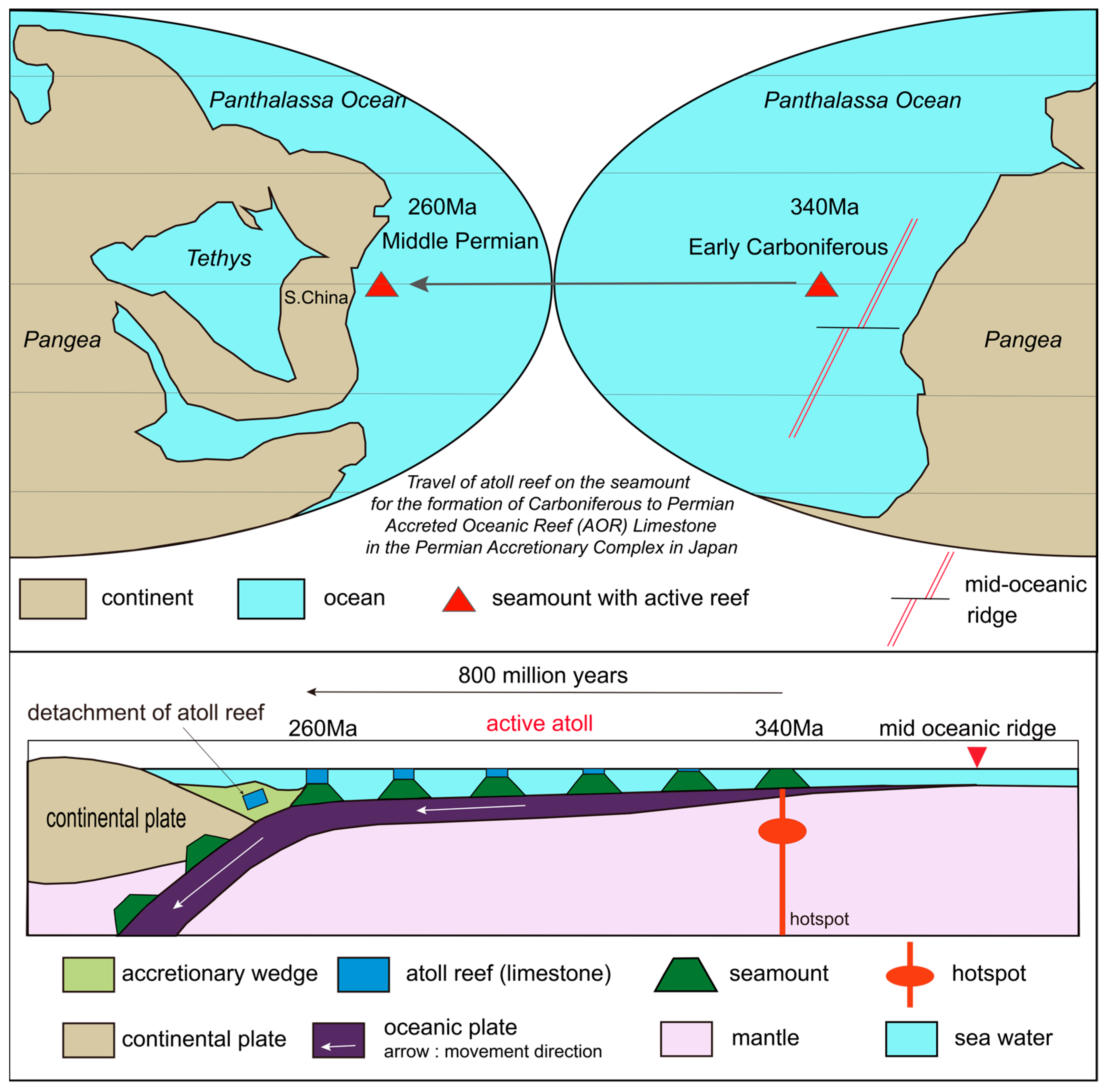
5.2. Karst Development in the Limestones of the Japanese Archipelago: Links to Tectonic History
6. Summary and Conclusions
Author Contributions
Funding
Data Availability Statement
Acknowledgments
Conflicts of Interest
References
- Ford, D.C. Karst geomorphology, caves and cave deposits: A review of North American contributions during the past half century. In Perspectives on Karst Geomorphology, Hydrology, and Geochemistry—A Tribute Volume to Derek C. Ford and William B. White; Harmon, R.S., Wicks, C.M., Eds.; GSA Special Paper 404: Boulder, CO, USA, 2006; pp. 1–12. [Google Scholar] [CrossRef]
- Parise, M.; Gabrovsek, F.; Kaufmann, G.; Ravbar, N. (Eds.) Recent advances in karst research: From theory to fieldwork and applications. In Advances in Karst Research: Theory, Fieldwork and Applicatios; Geological Society of London, Special Publication: London, UK, 2018; Volume 466, pp. 1–27. [Google Scholar] [CrossRef]
- Zerga, B. Karst topography: Formation, processes, characteristics, landforms, degradation and restoration: A systematic review. Watershed Ecol. Environ. 2024, 6, 252–269. [Google Scholar] [CrossRef]
- Sweeting, M.M. Karst in China—Its Geomorphology and Environment; Springer: Berlin/Heidelberg, Germany, 2012; 265p. [Google Scholar]
- Teibisz, T.; Mari, L. The significance of Karst areas in European national parks and geoparks. Open Geosci. 2020, 12, 117–132. [Google Scholar] [CrossRef]
- Gregorič, A.C. Typical Doline and Surface Landforms of Kras (Slovenia): Karst Landscape Features and Possibilities for Ther Conservation. Geoheritage 2021, 13, 26. [Google Scholar] [CrossRef]
- Jones, B. Void-filling deposits in karst terrains of isolated oceanic islands: A case study from Tertiary carbonates of the Cayman Islands. Sedimentology 1992, 39, 857–876. [Google Scholar] [CrossRef]
- Mylroie, J.E. Karst Features of Guam in terms of a general model of carbonate island karst. J. Cave Karst Strudies 2001, 63, 9–22. [Google Scholar]
- Jones, I.C.; Banner, J.L. Estimating recharge thresholds in toropical karst island aquifers: Barbados, Puerto Rico and Guam. J. Hydrol. 2003, 278, 131–143. [Google Scholar] [CrossRef]
- Jones, I.C.; Banner, J.L. Hydrogeologic and climatic influences on spatial and interannual variation of recharge to a tropical karst island aquifer. Water Resour. Res. 2003, 39. [Google Scholar] [CrossRef]
- Jenson, J.W.; Keel, T.M.; Mylroie, J.R.; Mylroie, J.E.; Stafford, K.W.; Tabrosi, D.; Wexel, C. Karst of the Mariana Islands: The interaction of tectonics, glacio-eustasy, and freshwater/seawater mixing in island carbonates. In Perspectives on Karst Geomorphology, Hydrology, and Geochemistry—A Tribute Volume to Derek C. Ford and William B. White; Harmon, R.S., Wicks, C.M., Eds.; Geological Society of America, Special Paper 404: Boulder, CO, USA, 2006; pp. 129–138. [Google Scholar] [CrossRef]
- Guidry, S.A.; Gramueck, M.; Carpenter, D.G.; Gomobos, A.M.; Bachtel, S.L.; Viggiano, D.A. Karst and Early Fracture Networks in Carbonates Turks and Caicos Island British West Indies. J. Sediment. Res. 2007, 77, 508–524. [Google Scholar] [CrossRef]
- Malago, A.; Efstathiou, D.; Bouraoui, F.; Nikolaidis, N.P.; Franchini, M.; Bidoglio, G.; Kritsotakis, M. Regional cale hydrologic modeling of a karst-dominant geomorphology: The case study of the Island of Crete. J. Hydorology 2016, 540, 64–81. [Google Scholar] [CrossRef]
- Knez, M.; Slabe, T.; Urushibara-Yoshino, K. Lithology, rock relief and karstification of Minamidaito Island (Japan). Acta Carsologica 2017, 45, 47–62. [Google Scholar] [CrossRef]
- Mylroie, J.E.; Vacher, H.L. A Conceptual View of Carbonate Island Karst. In Karst Modelling; Palmer, M.V., Sawowsky, I.D., Eds.; Karst Water Institute Special Publication: Lewisburg, PA, USA, 1999; Volume 5, pp. 48–57. [Google Scholar]
- Mylroie, J.E.; Carew, J.L. Karst Development on carbonate islands. In Speleogenesis and Evolution of Karst Aquifers; The American Association of Petroleum: Tulsa, OK, USA, 2003; Volume 1, pp. 1–21. [Google Scholar]
- Mylroie, J.R.; Mylroie, J.E. Development of the Carbonate Island Karst Model. J. Cave Karst Stud. 2007, 69, 59–75. [Google Scholar]
- Wakita, K.; Obara, H.; Oyama, N.; Murakami, T. Reassessing the Global Significance of Geological Heritages in the Miné-Akiyoshidai Karst Plateau Geopark. Geosciences 2025, 15, 56. [Google Scholar] [CrossRef]
- Wakita, K.; Nakagawa, T.; Sakata, M.; Tanaka, N.; Oyama, N. Phanerozoic accretionary history of Japan and the western Pacific margin. Geol. Mag. 2021, 158, 13–29. [Google Scholar] [CrossRef]
- Kato, Y.; Iwata, K.; Uozumi, S.; Nakamura, K. Re-examination on the Pre-Tertiary System distributed in the Toma-Kaimei district of central Hokkaido. J. Geol. Soc. Jpn. 1986, 92, 239–242. (In Japanese) [Google Scholar] [CrossRef]
- Ueda, H. Geologic structure of Cretaceous accretionary complexes in the frontal Hidaka collision zone, Hokkaido, Japan. J. Geol. Soc. Jpn. 2006, 112, 699–717, (In Japanese with English Abstract). [Google Scholar] [CrossRef]
- Kanmera, K.; Sano, H. Stratigraphic and structural relationships among pre-Jurassic accretionary and collisional systems in Akiyoshi Terrane. In Guidebook for Excursion, International Symposium on Pre-Jurassic East Asia, IGCP Project 224; Nippon Insatsu: Osaka, Japan, 1986; pp. 51–88. [Google Scholar]
- Kanmera, K.; Sano, H.; Isozaki, Y. Akiyoshi Terrane. In Pre-Cretaceous Terranes of Japan; Ichikawa, K., Mizutani, S., Hara, I., Hada, S., Yao, A., Eds.; Publication of IGCP Project 224; Nippon Insatsu Shuppan: Osaka, Japan, 1990; pp. 49–62. [Google Scholar]
- Sano, H.; Sugiyama, T.; Nagai, K.; Ueno, K.; Nakazawa, T.; Fujikawa, M. Carboniferous to Permian paleoenvironmental changes revealed in Akiyoshi Limestone—Commemorating field excursion for the 50th anniversary of the foundation of Akiyoshi-dai Museum of Natural History. J. Geol. Soc. Jpn. 2009, 115, S71–S88. [Google Scholar] [CrossRef]
- Wakita, K.; Kametaka, M. Beyond the Akiyoshi Orogeny: Unravelling overturned structures and tectonic processes in the Permian accretionary complex of the Mine-Akiyoshidai area, Yamaguchi, western Japan. J. Geol. Soc. 2024, 181, jgs2023-170. [Google Scholar] [CrossRef]
- Sano, H.; Hayasaka, Y.; Tazaki, K. Geochemical characteristics of Carboniferous greenstones in the Inner Zone of Southwest Japan. Island Arc 2000, 9, 81–96. [Google Scholar] [CrossRef]
- Tatsumi, Y.; Kani, T.; Ishizuka, H.; Maruyama, S.; Nishimura, Y. Activation of Pacific mantle plumes during the Carboniferous: Evidence from accretionary complexes in southwest Japan. Geology 2000, 28, 580–582. [Google Scholar] [CrossRef]
- Safonova, I.; Kojima, S.; Nakae, S.; Romer, R.L.; Seltmann, R.; Sano, H.; Onoue, T. Oceanic island basalts in accretionary complexes of SW Japan: Tectonic and petrogenetic implications. J. Asian Earth Sci. 2015, 113, 508–523. [Google Scholar] [CrossRef]
- Sada, K. The summary of the fusulinacean studies on the Carboniferous-Permian Taishaku Limestone in Hiroshima Prefecture, Japan. In Hiroshima Bunka Gakuen University Network Society Research Center Annual Research Report; Hiroshima Bunka Gakuen University: Hiroshima, Japan, 2014; Volume 10, pp. 1–12, (In Japanese with English Abstract). [Google Scholar]
- Sada, K. On the Upper Permian Fusulinid Fauna in the Atetsu Limestone Plateau, Okayama Prefecture. J. Geol. Soc. Jpn. 1960, 66, 410–425, (In Japanese with English Abstract). [Google Scholar] [CrossRef]
- Yamashita, M.; Ishiga, H. Correlation between the radiolarian and the fusulinacean biostratigraphy of the upper Middle Permian in Atetsu Plateau, Okayama Prefecture, Southwest Japan. J. Geol. Soc. Jpn. 1990, 96, 687–689. (In Japanese) [Google Scholar] [CrossRef]
- Yokoyama, T.; Hase, A.; Okimura, Y. Sedimentary Facies of Koyama Limestone. J. Geol. Soc. Jpn. 1979, 85, 11–25, (In Japanese with English Abstract). [Google Scholar] [CrossRef]
- Yokoyama, T. Sedimentary Facies of Nakamura Limestone. Chikyuukagaku (Earth Sci.) 1980, 34, 20–332, (In Japanese with English Abstract). [Google Scholar]
- Fujimoto, M.; Sada, K.; Oho, Y. Stratigraphy of the Shimodani Limestone in the southwestern part of the Oga area, Okayama Prefecture, western Japan. Fossils 1995, 58, 28–36, (In Japanese with English Abstract). [Google Scholar] [CrossRef]
- Murata, A.; Maekawa, H. Geological structures of the Torigatayama-Onogahara limestone and the Younger Ino metamorphic complex of the Chichibu Terrain, West Shikoku. Nat. Sci. Rearch Inst. Socio-Arts Sci. Univ. Tokushima 2013, 27, 91–100, (In Japanese with English Abstract). [Google Scholar]
- Kashima, N. New occurrence of fossils in the Ōnogahara area, Ehime Prefecture. J. Geol. Soc. Jpn. 1960, 66, 52. (In Japanese) [Google Scholar] [CrossRef]
- Kashima, N. Geology of the Oonogahara area, western Shikoku—Ukeana Melange. In Proceedings of the 105th Annual Meeting of the Geological Society of Japan, Matsumoto, Japan, 25–27 September 1998. [Google Scholar]
- Nakazawa, T. Sedimentary environments and reef-builders in the Carboniferous of the Omi Limestone Group. J. Geol. Soc. Jpn. 1997, 103, 849–868, (In Japanese with English Abstract). [Google Scholar] [CrossRef]
- Takeuchi, M.; Takenouchi, K.; Nakazawa, T. Geological exploration tour of the Itoigawa Geopark. J. Geol. Soc. Jpn. 2010, 116, S123–S142. [Google Scholar] [CrossRef]
- Fujikawa, M.; Nakazawa, T.; Ueno, K. Sedimentation and karstification of the Carboniferous-Permian Akiyoshi Limestone in the Akiyoshi accretionary complex. J. Geol. Soc. Jpn. 2019, 125, 609–631. (In Japanese) [Google Scholar] [CrossRef]
- Wakita, K. Tectonic setting required for the preservation of sedimentary mélanges in Palaeozoic and Mesozoic accretionary complexes of southwest Japan. Gondwana Res. 2019, 74, 90–100. [Google Scholar] [CrossRef]
- Murata, A. Chichibu Belt. In Regional Geology of Japan, Shikoku Region; Geological Society of Japan, Ed.; Asakura Publishing Co., Ltd.: Tokyo, Japan, 2016; pp. 103–201. [Google Scholar]
- Matsuoka, A.; Yamakita, S.; Sakakibara, M.; Hisada, K. Unit division for the Chichibu Composite Belt from a view point of accretionary tectonics and geology of western Shikoku, Japan. J. Geol. Soc. Jpn. 1988, 104, 634–653, (In Japanese with English Abstract). [Google Scholar] [CrossRef]
- Tazaki, K.; Sano, S.; Nagao, T.; Kasjima, N. Greenstones from Shikoku Karst: Comparative petrochemical study with basal greenstones of limestone plateau at Akiyoshi and Taishaku, Chugoku belt, southwest Japan. J. Mineral. Petrol. Econ. Geol. 1994, 89, 373–389, (In Japanese with English Abstract). [Google Scholar] [CrossRef]
- Hirata, M. Some Important New Facts from the Chichibu Zone of the Central Part of Shikoku. Chikyuu Kagaku (Earth Sci.) 1954, 36, 22–24, (In Japanese with English Abstract). [Google Scholar] [CrossRef]
- Hirata, M. Geology of Ohnogahara and Torigatayama areas. Chigaku Kenkyu (J. Geosci.) 1961, 12, 35–41. (In Japanese) [Google Scholar]
- Ishizaki, K. Stratigraphical and Paleontological Studies of the Onogahara and Its Neighbouring Area, Kochi and Ehime Prefectures, Southwest Japan. Ph.D. Thesis, Tohoku University, Sendai, Japan, 1962. [Google Scholar]
- Sakagami, S.; Kikukawa, T.; Shiraishi, K. Biostratigraphic study of the “Shikoku Karst” limestone-1—Fusulinacean fossils between Jiyoshi Pass and Godanjo. Mem. Ehime Univ. Nat. Sci. Ser. D Earth Sci. 1975, 7, 89–94. [Google Scholar]
- Kashima, N. Stratigraphical studies of the Chichibu Belt in Western Shikoku. Mem. Fac. Sci. Kyushu Univ. Ser. D Geol. 1969, 19, 387–436. [Google Scholar] [CrossRef]
- Kashima, N. Geology of the Onogahara area in western Shikoku—Proposal of Ukiana Melange. In Prof. Naruhiko Kashima Memorial Paper Collection; Retirement Commemorative Project Meeting of Prof. Aihiko Kashima; Ehime Geoscience Research Association: Ehime, Japan, 2000; pp. 1–15. [Google Scholar]
- Shikoku Geotechnical Consultants Association, Ehime Branch. On-Site Training Materials, Jiyoshi Tunnel No.1 Construction; Shikoku Geotechnical Consultants Association, Ehime Branch: Shikoku, Japan, 2005. (In Japanese) [Google Scholar]
- Tsuji, T.; Sakakibara, M. Large-scale overturned structure of the Northern Chichibu Belt in western Shikoku, Southwest Japan. J. Geol. Soc. Jpn. 2009, 115, 1–16, (In Japanese with English Abstract). [Google Scholar] [CrossRef]
- Tsuji, T. Geological Research of the Northern Chichibu Belt in Western Shikoku, Southwest Japan: Tectonic Modification of Accretionary Complexes by Orogenic Movement at Convergent Margins. Ph.D. Thesis, Graduate School of Science and Engineering Ehime University, Matsuyama, Japan, 2014; pp. 1–177, (In Japanese with English Abstract). [Google Scholar]
- Wakita, K.; Metcalfe, I. Ocean Plate Stratigraphy in East and Southeast Asia. J. Asian Earth Sci. 2005, 24, 679–702. [Google Scholar] [CrossRef]
- Isozaki, Y.; Maruyama, S.; Aoki, K.; Nakamura, T.; Miyashita, A.; Otoh, S. Geotectonic Subdivision of the Japanese Islands Revisited: Categorization and Definition of Elements and Boundaries of Pacific-type (Miyashiro-type) Orogen. J. Geogr. 2010, 119, 999–1053, (In Japanese with English Abstract). [Google Scholar] [CrossRef]
- Wakita, K. Mappable features of mélanges derived from Ocean Plate Stratigraphy in the Jurassic accretionary complexes of Mino and Chichibu terranes in Southwest Japan. Tectonophysics 2012, 568–569, 74–85. [Google Scholar] [CrossRef]
- Wakita, K. Geology and Tectonics of the Japanese Islands: A review—The key to understanding the geology of Asia. J. Asian Earth Sci. 2013, 72, 75–87. [Google Scholar] [CrossRef]
- Wakita, K. OPS mélange: A new term for mélanges of convergent margins of the world. Int. Geol. Rev. 2015, 57, 529–539. [Google Scholar] [CrossRef]
- Wakita, K. Origin of chaotically mixed bodies in the Early Jurassic to Early Cretaceous sedimentary complex of the Mino terrane, Central Japan. Bull. Geol. Surv. Jpn. 1988, 39, 675–757. [Google Scholar]
- Miyamura, M.; Mimura, K.; Yokoyama, T. Geology of the Hikonetobu District, Geological Map at a scale of 1:50,000; Geological Survey of Japan: Tsukuba, Japan, 1976; (In Japanese with English Abstract). [Google Scholar]
- Kobayashi, M. On some new species of Rauserella from Mt. Ibuki, Shiga Prefecture, central Japan. Trans. Proc. Palaeontol. Soc. Jpn. New Ser. 1956, 23, 225–228. [Google Scholar]
- Kobayashi, F. Permian fusuline faunas and biostratigraphy of the Akasaka Limestone (Japan). Rev. Paléobiol. 2011, 30, 431–574. [Google Scholar]
- Kobayashi, F. Middle Permian fusulines from the Funabuseyama area, Mino terrane, central Japan. Hum. Nat. 2021, 31, 1–40. [Google Scholar] [CrossRef]
- Sano, H. Permian Oceanic-Rocks of Mino Terrane, Central Japan, Part II. Limestone Facies. J. Geol. Soc. Jpn. 1988, 94, 963–976. [Google Scholar] [CrossRef]
- Sano, H.; Yamagata, T. Stratigraphy and age of the oceanic rocks of the Mino Belt in the Funafuseyama area. J. Geol. Soc. Jpn. 2020, 126, 365–381. (In Japanese) [Google Scholar] [CrossRef]
- Horibo, K. Petrography and depositional environment of Permian limestone of Mino terrane, Gujo-Hachiman, Gifu Prefecture, central Japan. J. Geol. Soc. Jpn. 1990, 96, 437–451, (In Japanese with English Abstract). [Google Scholar] [CrossRef]
- Kobayashi, F. Petrography and sedimentary environment of the Permian Nabeyama limestone in the Kuzuu area, Tochigi Prefecture, central Japan. J. Geol. Soc. Jpn. 1979, 10, 627–642. [Google Scholar] [CrossRef]
- Kobayashi, F. Middle Permian foraminifers of the Izuru and Nabeyama Formations in the Kuzu area, central Japan, Part 1, Schwagerinid, neoschwagerinid and verbeekinid fusulinoideans. Paleontol. Res. 2006, 85, 37–59. [Google Scholar] [CrossRef]
- Kobayashi, F. Middle Permian foraminifers of the Izuru and Nabeyama Formations in the Kuzu area, central Japan, Part 2, Schubertellid and ozawainellid fusulinoideans, and non-fusulinoidean foraminifers. Paleontol. Res. 2006, 10, 61–77. [Google Scholar] [CrossRef]
- Sugimoto, M.; Uda, S. On the Minor Structure of the Akka Limestone, Northern Kitakami Massif, Northeast Honshu, Japan. Bull. Kanazawa Univ. 1973, 22, 109–119, (In Japanese with English Abstract). [Google Scholar]
- Sano, S.; Sugiyama, N.; Shimaguchi, T. Discovery of megalodontoid bivalves in the Shiriya area, northern Honshu, Northeast Japan, and its geological implications. Mem. Fukui Prefect. Dinosaur. Mus. 2009, 8, 51–57, (In Japanese with English Abstract). [Google Scholar]
- Ota, A.; Kanmera, K.; Isozaki, Y. Stratigraphy of the Permian Iwato and Mitai Formations in the Kamura area, Southwest Japan: Maokouan, Wuchiapingianm and Changhsingian carbonates formed on paleo-seamount. J. Geol. Soc. Jpn. 2000, 106, 853–864, (In Japanese with English Abstract). [Google Scholar] [CrossRef]
- Kobayashi, F. Late Permian (Lopingian) Foraminifers from the Tsukumi Limestone, Southern Chichibu terrane of eastern Kyhshu, Japan. J. Foraminifer. Res. 2013, 43, 154–169. [Google Scholar] [CrossRef]
- Kanmera, K.; Furukawa, H. Stratigraphy of the Upper Permian and Triassic Konose Group, of the Sambosan belt in Kyushu. Bull. Fac. Sci. Kyushu Univ. 1964, 6, 237–258, (In Japanese with English Abstract). [Google Scholar]
- Igo, H. Conodonts, as a new index fossil in Japan. J. Geogr. 1972, 81, 142–151, (In Japanese with English Abstract). [Google Scholar] [CrossRef]
- Fujimoto, H. On the distribution of limestones in the Kanto Mountains. Gypsum Lime 1974, 29–36. Available online: https://www.jstage.jst.go.jp/article/mukimate1953/1974/128/1974_128_29/_pdf (accessed on 26 September 2025). (In Japanese).
- Tominaga, K.; Hisada, K.; Taniguchi, H.; Machida, S.; Yasukawa, K.; Kato, Y. Major and Trace element composition of the “Utozawa Schalstein” underlying the Bukozan Limestone in the Kanto Mountains, central Japan. In Proceedings of the 123th Annual Meeting of the Geological Society of Japan, Tokyo, Japan, 10–12 September 2016. (In Japanese). [Google Scholar]
- Kawamura, T.; Oyama, Y.; Hikichi, A.; Suino, Y.; Sasaki, K.; Kon-no, T.; Takano, Y. Revisiting Silurian stratigraphy of the Hikoroichi area, South Kitakami Terrane. Bull. Miyagi Univ. Educ. 2021, 56, 173–185, (In Japanese with English Abstract). [Google Scholar]
- Niikawa, I. Biostratigraphy and correlation of the Onimaru Formation in the southern Kitakami Mountains, Part I Geology and biostratiraphy. J. Geol. Soc. Jpn. 1983, 89, 347–357, (In Japanese with English Abstract). [Google Scholar] [CrossRef]
- Kano, A. Facies and Depositional Conditions of a Carbonate Mound (Tithonian-Berriasian, SW-Japan). Facies 1988, 18, 27–47. [Google Scholar] [CrossRef]
- Iryu, Y.; Nakamori, T.; Yamada, T. A unit of lithostratigraphic classification of the Ryukyu Group, Pleistocene reef complex deposits. J. Sedimentol. Soc. Jpn. 1992, 36, 57–66, (In Japanese with English Abstract). [Google Scholar] [CrossRef]
- Ehiro, M. 4.2. South Kitakami Belt, 4.2.2. Lower and Middle Paleozoic. In Editorial Committee of “Tohoku District”; Asakura Publishing Company Ltd.: Tokyo, Japan, 2017; pp. 185–195. [Google Scholar]
- Kurata, N. Geology of the Togano Basin and its Vicinity, Kochi Prefecture, with Special Reference to the Stratigraphy of the Torinosu Series. J. Geol. Soc. Jpn. 1940, 47, 507–516, (In Japanese with English Abstract). [Google Scholar] [CrossRef]
- Kimura, T. The Torinosu Group and the Torinosu Limestone in the Togano and Go Basins, Kochi Prefecture. J. Geol. Soc. Jpn. 1956, 62, 515–526, (In Japanese with English Abstract). [Google Scholar] [CrossRef]
- Yao, A.; Matsuoka, A.; Nakatani, T. Triassic and Jurassic radiolarian assemblages in Southwest Japan. News Osaka Micropaleontol. Spec. Vol. Proc. First Jpn. Radiol. Symp. 1982, 5, 27–43, (In Japanese with English Abstract). [Google Scholar]
- Aita, Y.; Okada, H. Radiolarians and calcareous nannofossils from the uppermost Jurassic and Lower Cretaceous strata of Japan and Tethyan regions. Micropaleontology 1986, 32, 97–128. [Google Scholar] [CrossRef]
- Ishida, K.; Kozai, T. Stratigraphy and tectonic subdivision of the Chichibu Superbelt in East Shikoku. Nat. Sci. Res. Fac. Integr. Arts Sci. Univ. Tokushima 2003, 16, 11–41, (In Japanese with English Abstract). [Google Scholar]
- Tamura, M. A stratigraphic study of the Torinosu Group and its relatives. Mem. Fac. Educ. Kumamoto Univ. 1960, 8, 1–40, (In Japanese with English Abstract). [Google Scholar]
- Kano, A.; Jiju, K. The Upper Jurassic-Lower Cretaceous carbonate-terrigenous succession and the development of a carbonate mound in western Shikoku, Japan. Sediment. Geol. 1995, 99, 165–178. [Google Scholar] [CrossRef]
- Tamura, M. The geologic history of the Torinosu Epoch and the Mesozoic reef-limestone in Japan. Jpn. J. Geol. Geogr. 1961, 32, 253–278. [Google Scholar]
- Nakagawa, K.; Suyari, K.; Ichikawa, K.; Ishii, K.; Yamashita, N. Geology of Kurosegawa District, Ehime Prefecture (Studies on the Chichibu-Terrain in Shikoku, 4). J. Gakugei Tokushima Univ. (Nat. Sci.) 1959, 9, 33–58, (In Japanese with English Abstract). [Google Scholar]
- Takei, M.; Matsuoka, A. Megafossil-bearing mudstone blocks in the Oriai Formation of the Upper Jurassic Imaidani Group in the Shirokawa area, Ehime Prefecture, Southwest Japan. J. Geol. Soc. Jpn. 2004, 110, 146–157, (In Japanese with English Abstract). [Google Scholar] [CrossRef]
- Takayasu, K. “Ryukyu Limestone” of Okinawa-jima, South Japan―A Stratigraphical and Sedimentological Study. Memoiors Fac. Sci. Kyoto Univ. Ser. Geol. Mineral. 1978, XLV, 133–175. [Google Scholar]
- Kizaki, K. Geology and Tectonics of the Ryukyu Islands. Tectonophysics 1986, 125, 193–207. [Google Scholar] [CrossRef]
- Kaneko, N. Cenozoic stratigraphy of Okinawa Island and Ryukyu Arc. Chishitsu News 2007, 633, 22–30. (In Japanese) [Google Scholar]
- Nakae, S.; Kaneko, N.; Miyazaki, K.; Ohno, T.; Komazawa, M. Yoron Jima and Naha, Geological Map of Yoron Jima and Naha, 1:200,000; Geological Survey of Japan, AIST: Tsukuba, Japan, 2010; (In Japanese with English Abstract). [Google Scholar]
- Maeda, H.; Oyama, N. Stratigraphy and fossil assemblages of the Triassic Mine Group and Jurassic Toyora Group, western Yamaguchi Prefecture. J. Geol. Soc. Jpn. 2019, 125, 585–594. (In Japanese) [Google Scholar] [CrossRef]
- Hoshi, H.; Iwano, H.; Danhara, T.; Sako, K. U-Pb evidence for rapid formation of the Nohi Rhyolite at about 70Ma. In Proceedings of the Annual Meeting of the Geological Society of Japan, Tokyo, Japan, 10–12 September 2016. (In Japanese). [Google Scholar] [CrossRef]
- Matsuda, T.; Kinugasa, Y. Quateranary Tectonic Movements—The Characteristics and the Related Problems on the Japanese Islands. Quat. Res. 1988, 26, 251–254, (In Japanese with English Abstract). [Google Scholar] [CrossRef]
- Shiba, M. Characteristics of crustal uplift since the Pliocene in central Honshu, Japan. Earth Sci. (Chikyuu Kagaku) 2021, 75, 37–55, (In Japanese with English Abstract). [Google Scholar] [CrossRef]
- Fujiwara, O.; Yanagida, M.; Sanko, T.; Moriya, T. Research on the uplift and erosion of the Japanese Islands from the perspective of geological disposal. Nucl. Backend Res. 2005, 11, 113–124, (In Japanese with English Abstract). [Google Scholar] [CrossRef]
- Fujii, A. Age of establishment of Akiyoshi Limestone Caves—Based on the estimation of undercut speed in the Koto River. Mammal Study 2009, 49, 91–95. (In Japanese) [Google Scholar] [CrossRef]
- Fujii, A.; Momikura, Y.; Nakayama, Y. On the buried terraces beneath the Ryukyu Group of Okierabu-jima (island) and Quaternary eustatic movement. J. Geol. Soc. Jpn. 1974, 80, 45–47. (In Japanese) [Google Scholar] [CrossRef]
- Kizaki, K. Geology of Ryukyu Arc; Okinawa Times: Naha, Japan, 1985; 798p. (In Japanese) [Google Scholar]
- Murakami, T.; Speleological Survey Group of Yamaguchi University. The three-dimensional structure and origin of the Taishodo-Inugamori Cave. Yamaguchi Caving Club Newsl. 2017, 53, 13–15. (In Japanese) [Google Scholar]
- Fujii, A. A Hypothesis of Karst Chronology based on Rate of Limestone Denudation in Chugoku and Kitakyushu Districts, Southwest Japan. J. Speleol. Soc. Jpn. 2005, 30, 1–28. (In Japanese) [Google Scholar]
- Haikawa, T. Karst Depressions in the Umakorobi Area and Its Registration; Akiyoshidai Groundwater System Research and Protection Association: Mine, Japan, 2015; 24p. (In Japanese) [Google Scholar]
- Matsushi, Y.; Hattanji, T.; Akiyama, S.; Sasa, K.; Takahashi, T.; Sueki, K.; Matsukura, Y. Erosion of solution dolines inferred from cosmogenic 36Cl in calcite. Geology 2010, 38, 1039–1042. [Google Scholar] [CrossRef]
- Akiyama, S.; Hattanji, T.; Maatushi, Y.; Matsukura, Y. Dissolution rates of subsoil limestone in a doline on the Akiyoshi-dai Plateau, Japan: An approach from a weathering experiment, hydrological observations, and electrical resistivity tomography. Geomorphology 2015, 247, 2–9. [Google Scholar] [CrossRef]
- Yoshihara, N.; Hiramoto, N.; Hattanji, T. Subsurface structures of solution dolines inferred from electrical resistivity tomography: A hypothesis on the evolutionary process of solution dolines at the Akiyoshi—Dai Plateau, southwest Japan. Geomorphology 2023, 442, 108921. [Google Scholar] [CrossRef]
- Haikawa, T. The Drainage System of the Akiyoshi-dai Plateau, western Japan. Bull. Akiyoshi-Dai Mus. Nat. Hist. 2006, 41, 17–31. (In Japanese) [Google Scholar]
- Haikawa, T. The Drainage System of the Western Akiyoshi-dai Plateau, Japan. Bull. Akiyoshi-Dai Mus. Nat. Hist. 2007, 42, 19–32. (In Japanese) [Google Scholar]
- Yamaguchi Caving Club. Location Map of Limestone Caves, Akiyoshi Plateau, Japan; Yamaguchi Caving Club: Mine, Japan, 2012. 1/25,000. (In Japanese) [Google Scholar]
- Murakami, T.; Ishihara, Y.; Kuma, H.; Goto, S.; Murase, T. Speleological Survey Group of Yamaguchi University, Overview of a New Passage ‘Shusho-den’ Discovered in Akiyoshi-do (cave), Yamaguchi Prefecture, Southwest Japan. J. Speleol. Soc. Jpn. 2020, 45, 41–55. (In Japanese) [Google Scholar]
- Murakami, T.; Kimura, H.; Watanabe, Y.; Kanegae, R.; Nakamura, M. Cave Survey of the Connecting Passage between Kuzuga-ana and Dainana-shindo of Akiyoshi-do, Mine, Yamaguchi Prefecture. Abstract of the 48th Annual Meeting of the Speleological Society of Japan. Caving J. 2023, 77, 46–47. (In Japanese) [Google Scholar]
- Fujii, A.; Kawano, M. An Attempt of Discrimination between the Recharge and Discharge Areas in the Akiyoshi do Cave Drainage Basin, Akiyoshi dai Plateau, Japan. J. Speleol. Soc. Jpn. 1995, 45, 41–55. (In Japanese) [Google Scholar]
- Kuma, H. 3D Laser Scanning of Akiyoshi-do Cave. Chikyu Mon. Spec. 2023, 74, 49–56. (In Japanese) [Google Scholar]
- Sakurai, S. Into the Unexplored Great Cave—The Exploration Story of Akiyoshido Cave; Kaichosya: Fukuoka, Japan, 1999; 235p. (In Japanese) [Google Scholar]
- Ishihara, Y. Overview of the Connecting Passage between Kuzuga-ana Cave and Dainana-shindo of Akiyoshi-do Cave. In Proceedings of the 25th Annual Meeting of the Speleological Society of Japan, Akiyoshi-dai, Japan; 1999; pp. 37–38. (In Japanese). [Google Scholar]
- Ota, M.; Sugimura, A.; Haikawa, T. Akiyoshi Limestone Group and its geological structure. In Science of Akioshidai Caves; Kawano, M., Ed.; Kisui-kai: Yamaguchi, Japan, 1980; 31p. (In Japanese) [Google Scholar]
- Yagi, T.; Tanaka, K. 2010, Geological studies on large breakdown stone deposits in Akiyoshi-Do cave, Mine city. In Proceedings of Annual Meeting of Japan Society of Engineering Geology; Japan Society of Engineering Geology: Tokyo, Japan, 2010; pp. 207–208. (In Japanese) [Google Scholar]
- Fujii, A.; Sugimura, A.; Nojima, S. Origin and development of the Akiyoshi-do (cave). Cave Study 1973, 5, 1–23. (In Japanese) [Google Scholar]
- Fujii, A. Hypothesis: Akiyoshido Cave is 700,000 years old. Shuho Town Local Cult. Res. 2008, 44, 26–28. (In Japanese) [Google Scholar]
- Ikeya, M. Dating a stalactite by electon paramagnetic resonance. Nature 1975, 255, 40–50. [Google Scholar] [CrossRef]
- Ikeya, M.; Baffa, F.O.; Mascarenhas, S. ESR dating of cave deposits from Akiyoshi-do Cave in Japan and Diabo Cavern in Brazil. J. Speleol. Soc. Jpn. 1984, 9, 58–67. [Google Scholar]
- Fujii, A. On the Age of the Terrace Gravel Layer at Kotogabuchi in Akiyoshido Cave. Cave Stud. 1969, 1, 1–3. (In Japanese) [Google Scholar]
- Murakami, T.; Urata, K.; Tozawa, M.; Murase, T.; Akiyoshi-dai Karst Speleological Research Group. The Connection of Taisho-do (cave) and Inugamori-no-ana (cave), and the Newly Discovered Passages in the Caves, Akiyoshi-dai karst, Yamaguchi Prefecture, Japan. J. Speleol. Soc. Jpn. 2015, 40, 19–32. (In Japanese) [Google Scholar]
- Murakami, T.; Kuroda, T.; Tajima, D.; Goto, S. Tokyo University of Agriculture Exploration Club, Speleological Survey Group of Yamaguchi University, Cave Morphology of a Newly Discovered Branch of Taisho-do Cave Opening into a Sinkhole Upstream of Inugamori Ponor. Yamaguchi Caving Club Newsl. 2022, 57, 12–15. (In Japanese) [Google Scholar]
- Nakagawa, K.; Imamura, O.; Hiramoto, T. Taisho-do Drainage Cave System at the Northern Part of the Akiyoshi-dai Plateau -A Model of Development of Phreatic Cave Systems. J. Speleol. Soc. Jpn. 1979, 4, 32–41. (In Japanese) [Google Scholar]
- Kawano, M. Formation of limestone caves and geomorphological development of Oku-Akiyoshidai. Res. Rep. Yamaguchi Jr. Coll. 1981, 3, 23–35. (In Japanese) [Google Scholar]
- Urata, K. The importance of paragenesis in the cave formation process of Akiyoshidai Plateau—Reexamination of the formation process of Dobiniwa-no-ana, Taisho-do and Kagekiyo-do. Yamaguchi Caving Club Newsl. 2009, 44, 9–10. (In Japanese) [Google Scholar]
- Murase, T. Connection of Kagekiyo-ana and Anakuchino-ana. Yamaguchi Caving Club Newsl. 2023, 58, 11. (In Japanese) [Google Scholar]
- Usami, K. Illustration of Water Channels in Misumatado-Kagekiyodo Cave: Ponors, Springs, and branch passages. Yamaguchi Caving Club Newsl. 1990, 25, 2–9. (In Japanese) [Google Scholar]
- Kawano, M. Survey on the morphology of Kagekiyodo Cave. Yamaguchi Caving Club Newsl. 1983, 19, 13–16. (In Japanese) [Google Scholar]
- Speleological Survey Group of Yamaguchi University; Kawano, M. Major Caves in Akiyoshidai. In Science of Akioshidai Caves; Kawano, M., Ed.; Kisui-kai: Yamaguchi, Japan, 1980; pp. 213–243. (In Japanese) [Google Scholar]
- Morita, M.; Hirase, K.; Yasuoka, K. The karst landscapes and dairies around Oonogahara, Shikoku, Japan. Mem. Osaka Kyoiku Univ. II Soc. Sci. Home Econ. 1978, 26, 95–126, (In Japanese with German Abstract). [Google Scholar]
- Kondo, S. (Ed.) Rakan-ana. In Introduction and Guide for Caving; Yama-to-Keikoku Co., Ltd.: Tokyo, Japan, 1995; pp. 214–215. (In Japanese) [Google Scholar]
- Ehime Prefectural Board of Education, Cultural Properties Protection Division (Ed.) Geology and Minerals of Ehime Prefecture: Report on the Emergency Survey of Natural Monuments (Geology and Minerals); Ehime Prefectural Board of Education: Matsuyama, Japan, 2003; 194p. (In Japanese)
- Geological Survey of Japan, AIST, Seamless Digital Geological Map of Japan V2 1:200,000, Original Edition, 2025. Available online: https://gbank.gsj.jp/seamless/ (accessed on 4 August 2025).
- Geospatial Information Authority of Japan, GSI Maps, 2025. Available online: https://maps.gsi.go.jp/#15/33.479008/132.872128/&base=std&ls=std&disp=1&vs=c0g1j0h0k0l0u0t0z0r0s0m0f1/ (accessed on 4 August 2025).
- Nakamura, M.; Ohkohchi, S.; Kanegae, R.; Sato, A.; Shimada, A.; Namba, T.; Ueno, T.; Sadano, M.; Tsuji, T.; Murakami, T. Cave Survey of Rakan-Ana, Seiyo, Ehime-Prefecture, Abstract of the 48th Annual Meeting of the Speleological Society of Japan. Caving J. 2023, 77, 47. (In Japanese) [Google Scholar]
- Geological Survey of Japan, AIST, Seamless Digital Geological Map of Japan V2 1:200,000, Original Edition, 2025. Available online: https://gbank.gsj.jp/seamless/v2/viewer/?center=33.3842%2C132.6026&z=12&opacity=1&selector=32511&marker=39.0996%2C140.0507 (accessed on 12 August 2025).
- Murakami, T.; Goto, S.; Murase, T. Speleological Survey Group of Yamaguchi University, Kawazuminami Yatchimiru-kai, Overview of the Anagami-syonyudo, Designated Natural Monument of Seiyo City, Ehime Prefecture, Western Japan. Abstract of the 45th Annual Meeting of the Speleological Society of Japan. Caving J. 2020, 68, 23. (In Japanese) [Google Scholar]
- Ford, D.; Williams, P. Karst Hydrogeology and Geomorphology Revised Edition; Wiley: Hoboken, NJ, USA, 2007; 562p. [Google Scholar]
- Yoshimura, K. Tufa. In Karst: The Environment and Human Interaction; Urushibara, K., Ed.; Taimeido: Tokyo, Japan, 1966; p. 277. (In Japanese) [Google Scholar]
- Kano, A.; Kamkibayashi, T.; Fujii, H.; Mastuoka, J.; Sakuma, K.; Ihara, T. Seasonal variation in water chemistry and hydrological conditions of tufa deposition of Shirokawa, Ehime Prefectrure, southwestern Japan. J. Geol. Soc. Jpn. 1999, 105, 289–304. [Google Scholar] [CrossRef]
- Kano, A.; Fujii, H. Origin of the gross morphology and internal texture of tufas of Shirokawa Town, Ehime Prefecture, southwest Japan. J. Geol. Soc. Jpn. 2000, 106, 397–412. [Google Scholar] [CrossRef]
- Shiraishi, F.; Okumura, T.; Takahashi, Y.; Kano, A. Influence of microbial photosynthesis on tufa stromatolite formation and ambient water chemistry, SW Japan. Geochim. Cosmochim. Acta 2010, 74, 5289–5304. [Google Scholar] [CrossRef]
- Sano, S.; Rineau, V.; Hiraoka, M.; Hori, R. Discovery of the Epidiceras bed in the Torinosu-type limestone in Kuranuki, Seiyo City, Ehime Prefecture, Southwest Japan. In Proceedings of the 173rd Annual Meeting of the Palaeontological Society of Japan, Sendai, Japan, 26–28 January 2024; p. 34. (In Japanese). [Google Scholar]
- Urata, K. Formation of the Hirao-dai karst system, Fukuoka Prefecture, Japan. Bull. Akiyoshi-Dai Mus. Nat. Hist. 2009, 44, 5–45. (In Japanese) [Google Scholar]
- Wigley, T.M.L.; Brown, M.C. The Physics of Caves. In The Science of Speleology; Ford, T.D., Cullingford, C.H.D., Eds.; Academic Press: London, UK, 1976; pp. 329–358. [Google Scholar]
- Omura, A.; Ota, Y. Paleo sea-level change during the last 300,000 years deduced from the morpho-stratigraphy of coral reef terraces and 230Th/234U ages of terrace deposits. Quat. Res. 1992, 31, 313–327. (In Japanese) [Google Scholar] [CrossRef]
- Ota, Y.; Omura, A. Contrasting styles and rates of tectonic uplift of coral reef terrace on the Ryukyu and Daito Islands, southwest Japan. Quat. Int. 1992, 15, 17–29, (In Japanese with English Abstract). [Google Scholar] [CrossRef]
- Ota, Y.; Kawana, T.; Omura, A. 4.2. Ryukyu Outer Arc. In Topography of Japan 7 Kyusyu and Southwest Islands; Machida, H., Ota, Y., Kawana, T., Moriwaki, H., Nagaoka, S., Eds.; University of Tokyo Press: Tokyo, Japan, 2001; pp. 232–271. (In Japanese) [Google Scholar]
- Urata, K.; Nakai, T.; Kimura, H.; Fujita, Y. Geomorphology and its Formation of Nagashima Limestone Cave off the Henoko-Aakim Nago City, Okinawa Prefecture, Japan. Okinawa J. Geogr. Stud. 2021, 21, 55–71. (In Japanese) [Google Scholar]
- Urata, K.; Nakai, T.; Kimura, H.; Fujita, Y. Effect of sea-level change to limestone stalactite caves in the Pacific coast area of North-Central Okinawa-jima, Ryukyu Islands, Japan. In Proceedings of the Annual Meeting of the Geographical Society of Japan, Annual Session, Hachiōji City, Japan, 25–27 March 2023. (In Japanese). [Google Scholar] [CrossRef]
- Iryu, Y.; Matsuda, H. Neogene and Quaternary. In Regional Geology of Japan, Vol. 8: Kyushu and Okinawa; Geological Society of Japan, Ed.; Asakura Publishing Co., Ltd.: Tokyo, Japan, 2010; pp. 149–154. (In Japanese) [Google Scholar]
- Gillieson, D. Karst of Okinawa and Kikai, Japan: Geomorphology and Management. In Cave Management in Australasia, 15, Proceedings of the 15th ACKMA Conference, Chillagoe, Australia, 5–11 May 2003; ACKMA Inc.: Carlton South, Australia, 2003. [Google Scholar]
- Nambu, A.; Inagaki, S.; Ozawa, S.; Suzuki, Y.; Iryu, Y. Stratigraphy of reef deposits on Kita-daito-jima, Japan. J. Geol. Soc. Jpn. 2003, 109, 617–634, (In Japanese with English Abstract). [Google Scholar] [CrossRef]
- Geospatial Information Authority of Japan, GSI Maps, 2025. Available online: https://maps.gsi.go.jp/#13/27.378551/128.612051/&ls=hillshademap%7Crelief_free%2C0.5&blend=1&disp=11&lcd=relief_free&vs=c0g1j0h0k0l1u0t0z0r0s0m0f1&d=m&reliefdata=0AG0000FFG1EG0095FFG32G00EEFFG64G91FF00G96GFFFF00GC8GFF8C00GGFF4400 (accessed on 12 August 2025).
- GSJ-AIST, Seamless Geological Map of Japan, 2025. Available online: https://gbank.gsj.jp/seamless/v2/viewer/?center=27.3830%2C128.6254&z=12&opacity=0.48&marker=39.0996%2C140.0507 (accessed on 13 August 2025).
- Smart, P.L.; Richards, D.A.; Edwards, R.L. Uranium-series ages of speleothems from South Andros, Bahamas: Implications for Quaternary sea-level history and palaeoclimate. Cave Karst Sci. 1998, 25, 67–74. [Google Scholar]
- Koba, M. Distribution and Age of the Marine Terraces and their Deposits in the Reef-capped Ryukyu Islands, Japan. Quat. Res. 1980, 18, 189–208, (In Japanese with English Abstract). [Google Scholar] [CrossRef]
- Kan, H.; Hori, N.; Nakashima, Y.; Ichikawa, K. The evolution of narrow reef flats at high-latitude in the Ryukyu Islands. Coral Reefs 1995, 14, 123–130. [Google Scholar] [CrossRef]
- Ota, M.; Nishida, T.; Sugimura, A.; Fujii, A.; Haikawa, T. Caverns of the Okinoerabu island. Jpn. Caving 1975, 7, 49–72. (In Japanese) [Google Scholar]
- Iida, S. Survey Report on ‘Yukei-do’, the Upper Reaches of the Shoryudo Cave System, Okinoerabu Island. Caving J. 2011, 41, 36–37. (In Japanese) [Google Scholar]
- Ishikawa, H.; Hayasaka, S.; Hatae, N. Geology of the Limestone Caves of Okierabu-jima, Kagoshima Prefecture—Especially on the Geology of Shoryudo Cave. Bull. Fac. Educ. Univ. Kagoshima Nat. Sci. 1968, 20, 25–30. (In Japanese) [Google Scholar]
- Iryu, Y.; Nakamori, T.; Yamada, T. Pleistocene Reef Complex Deposits in the Central Ryukyus, South-Western Japan. In Reefs and Carbonate Platforms in the Pacific and Indian Oceans; Camoin, G.F., Davies, P.J., Eds.; Wiley: Hoboken, NJ, USA, 1998; pp. 197–213. [Google Scholar] [CrossRef]
- Okayama University Caving Club. Activity Report; Okayama University Caving Club: Okayama, Japan, 1985; No. 6; 47p. [Google Scholar]
- Urata, K. The origin and development of the Ginga-do Cave System, Tokuno-shima, the Ryukyus. J. Speleol. Soc. Jpn. 1986, 11, 34–42, (In Japanese with English Abstract). [Google Scholar]
- Kindai University Exploration Club. Okinoerabu Island Academic Fieldwork Report; Guano, Kindai University Exploration Club: Osaka, Japan, 2000; Volume XXIV, 138p. (In Japanese) [Google Scholar]
- Clague, D.; Sherrod, D.R. Growth and degradation of Hawaiian volcanoes. In USGS Professional Paper 1801-3; U.S. Geological Survey: Reston, VA, USA, 2014; pp. 97–146. [Google Scholar] [CrossRef]
- Scotese, C.R.; Song, H.; Mills, B.J.W.; van der Meer, D.G. Phanerozoic paleotemperatures: The earth’s changing climate during the last 540 million years. Earth-Sci. Rev. 2021, 215, 103503. [Google Scholar] [CrossRef]
- Scotese, C.R. An Atlas of Phanerozoic Paleogeogarphic Maps: The Seas Come In and the Seas Go Out. Annu. Rev. Earth Planet. Sci. 2021, 49, 669–718. [Google Scholar] [CrossRef]
- Isozaki, Y.; Maruyama, S. Studies on Orogeny based on Plate Tectonics in Japan and New Geotectonic Subdivision of the Japanese Islands. J. Geogr. 1991, 100, 697–761, (In Japanese with English Abstract). [Google Scholar] [CrossRef] [PubMed]
- Isozaki, Y.; Maruyama, S.; Nakama, T.; Yamamoto, S.; Yanai, S. Growth and Shrinkage of an Active Continental Margin: Updated Geotectonic History of the Japanese Islands. J. Geogr. 2011, 120, 65–99, (In Japanese with English Abstract). [Google Scholar] [CrossRef]
- Yamamoto, H. Geology of the late Paleozoic-Mesozoic sedimentary complex of the Mino Terrane in the southern Neo area, Gifu Prefecture and the Mt. Ibuki area, Shiga Prefecture, central Japan. J. Geol. Soc. Jpn. 1985, 91, 353–369, (In Japanese with English Abstract). [Google Scholar] [CrossRef]
- Stein, C.A.; Stein, S. A model for the global variation in oceanic depth and heatflow with lithospheric age. Nature 1992, 359, 123–130. [Google Scholar] [CrossRef]
- Safonova, I.Y. Interplate magmatisim and oceanic plate stratigraphy of the Paleo-Asian and Paleo-Pacific Oceans from 600 to 140 Ma. Ore Geol. Rev. 2009, 35, 137–154. [Google Scholar] [CrossRef]
- Dai, X.; Du, Y.; Ziegier, M.; Wang, C.; Ma, Q.; Chai, R.; Guo, H. Middle Triassic to Late Jurassic climate change on the northern margin of the South China Plate: Insights from chemical weathering indices and clay mineralogy. Palaeogeogr. Palaeoclimatol. Palaeoecol. 2022, 585, 110744. [Google Scholar] [CrossRef]
- Hattori, I.; Yoshimura, M. Late Triassic to Middle Jurassic Ages for Greenstones within the Mesozoic Nanjo Massif of the Mino Terrane, Central Japan. Bull. Fac. Educ. Univ. Fukui II Nat. Sci. 1983, 32, 67–80, (In Japanese with English Abstract). [Google Scholar]
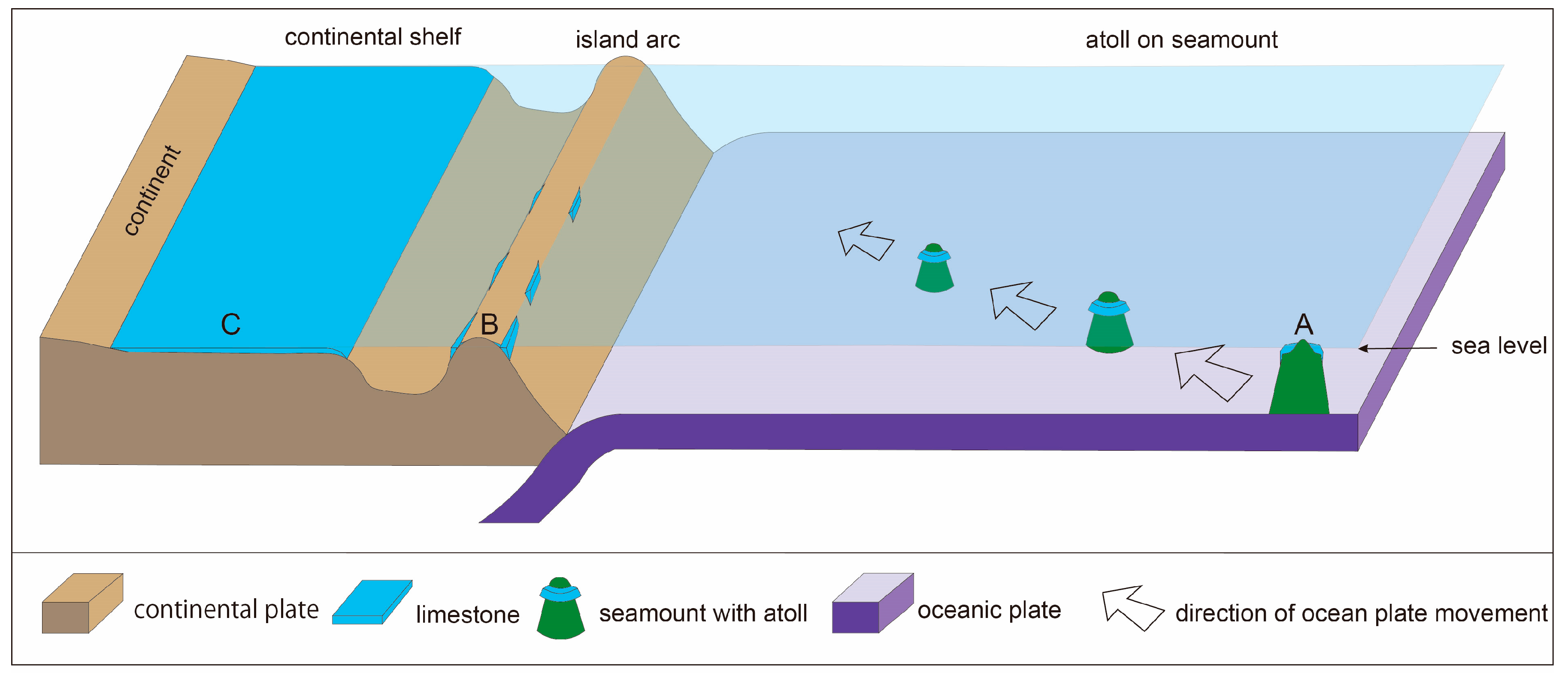
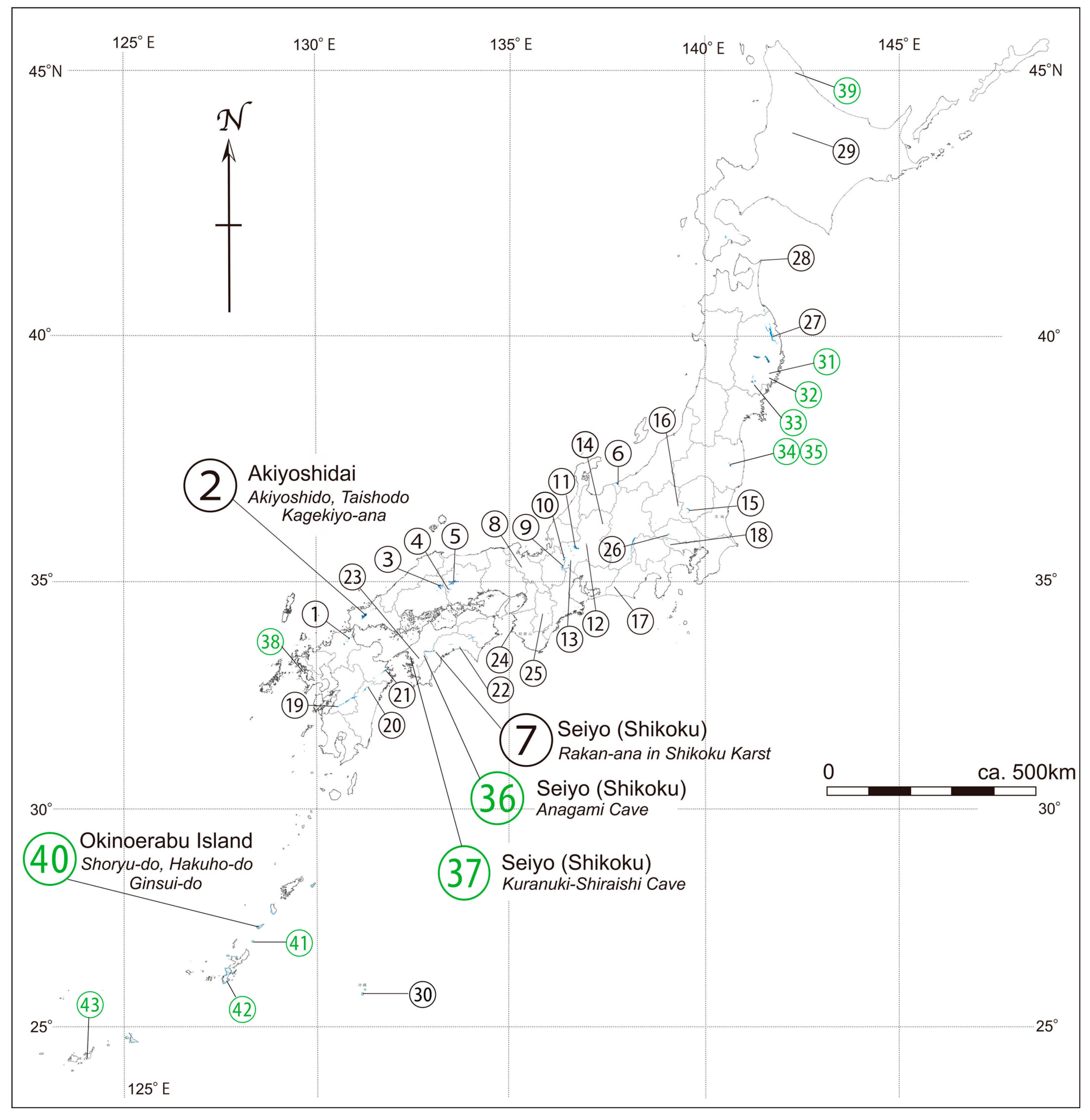
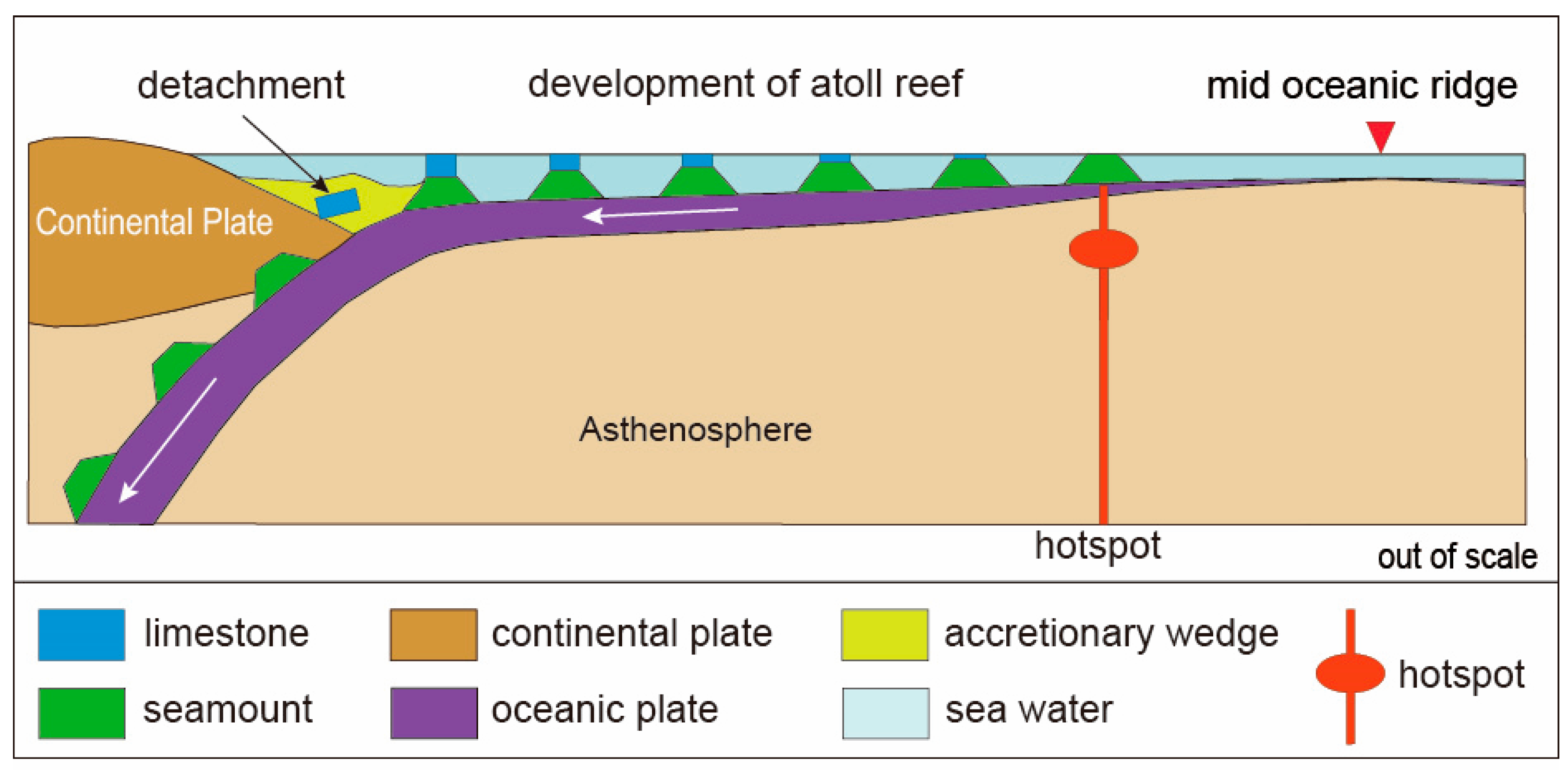

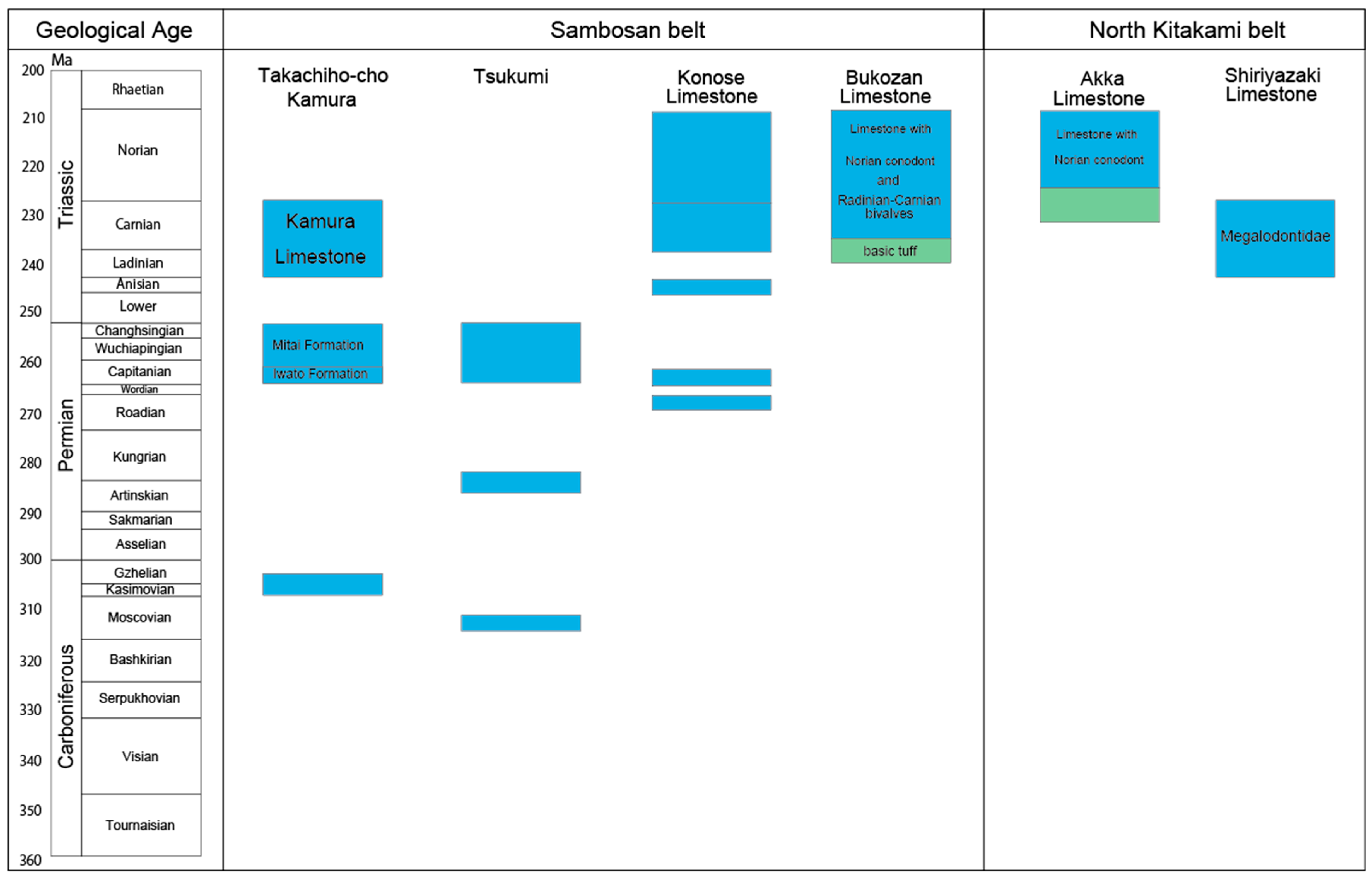
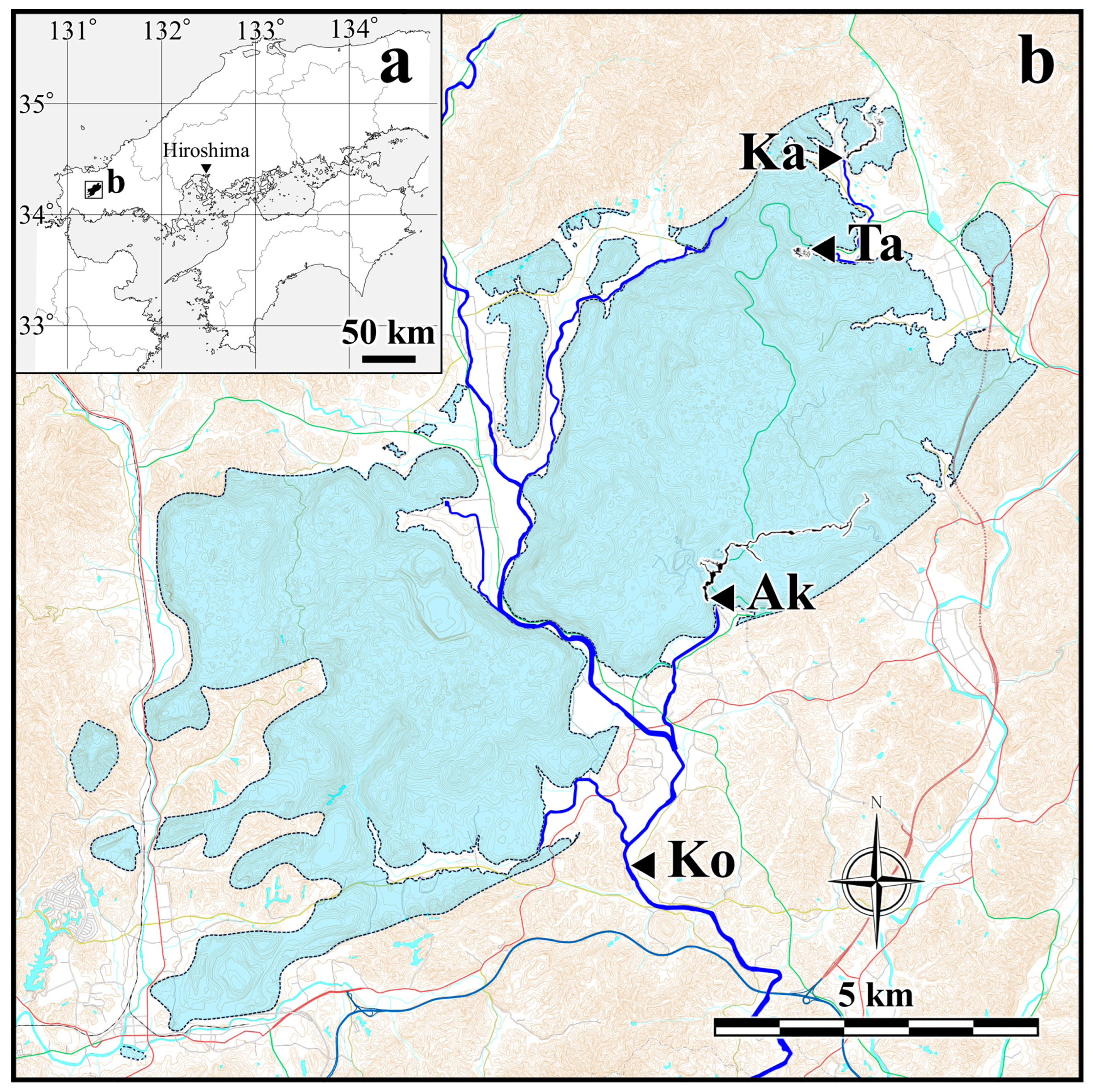

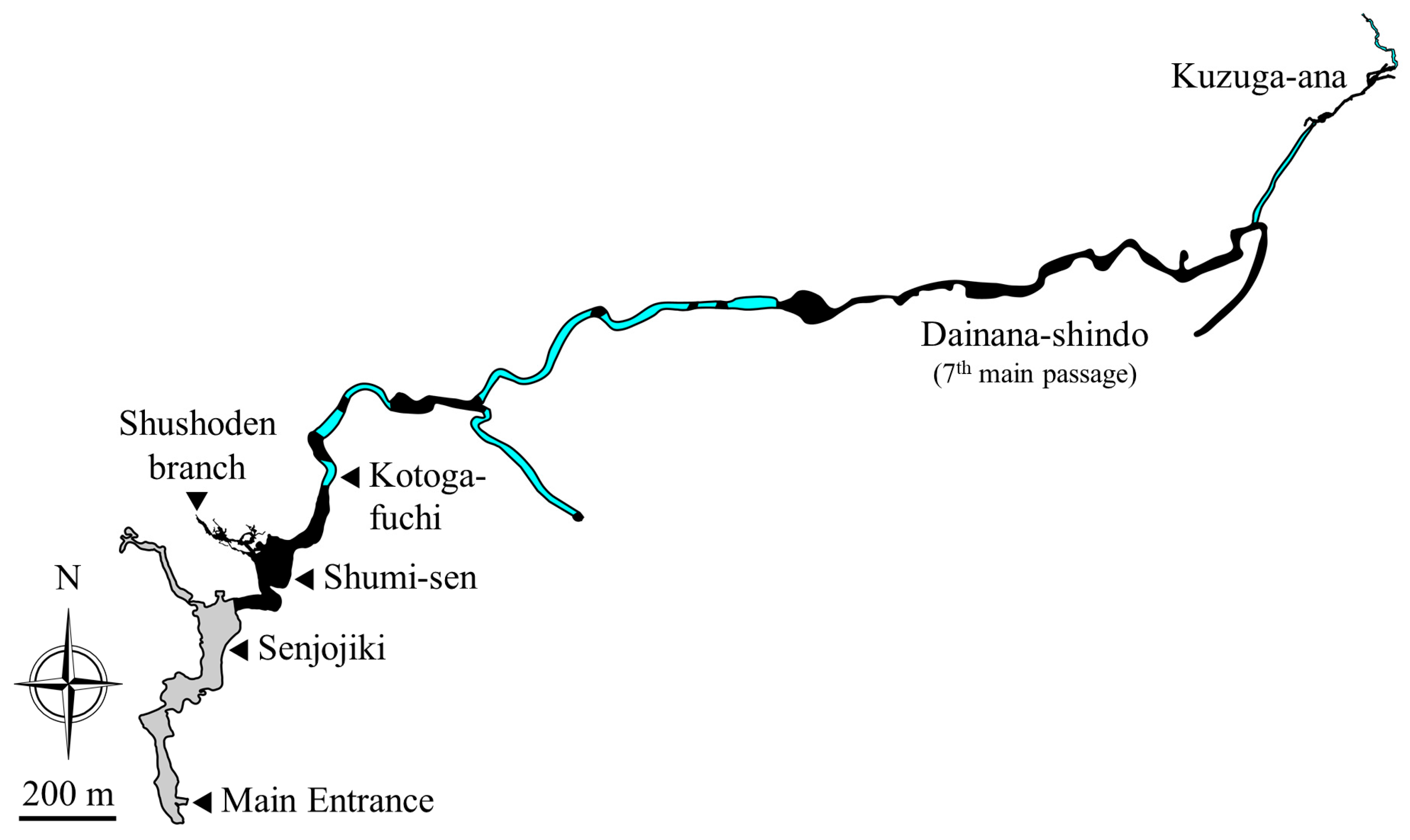
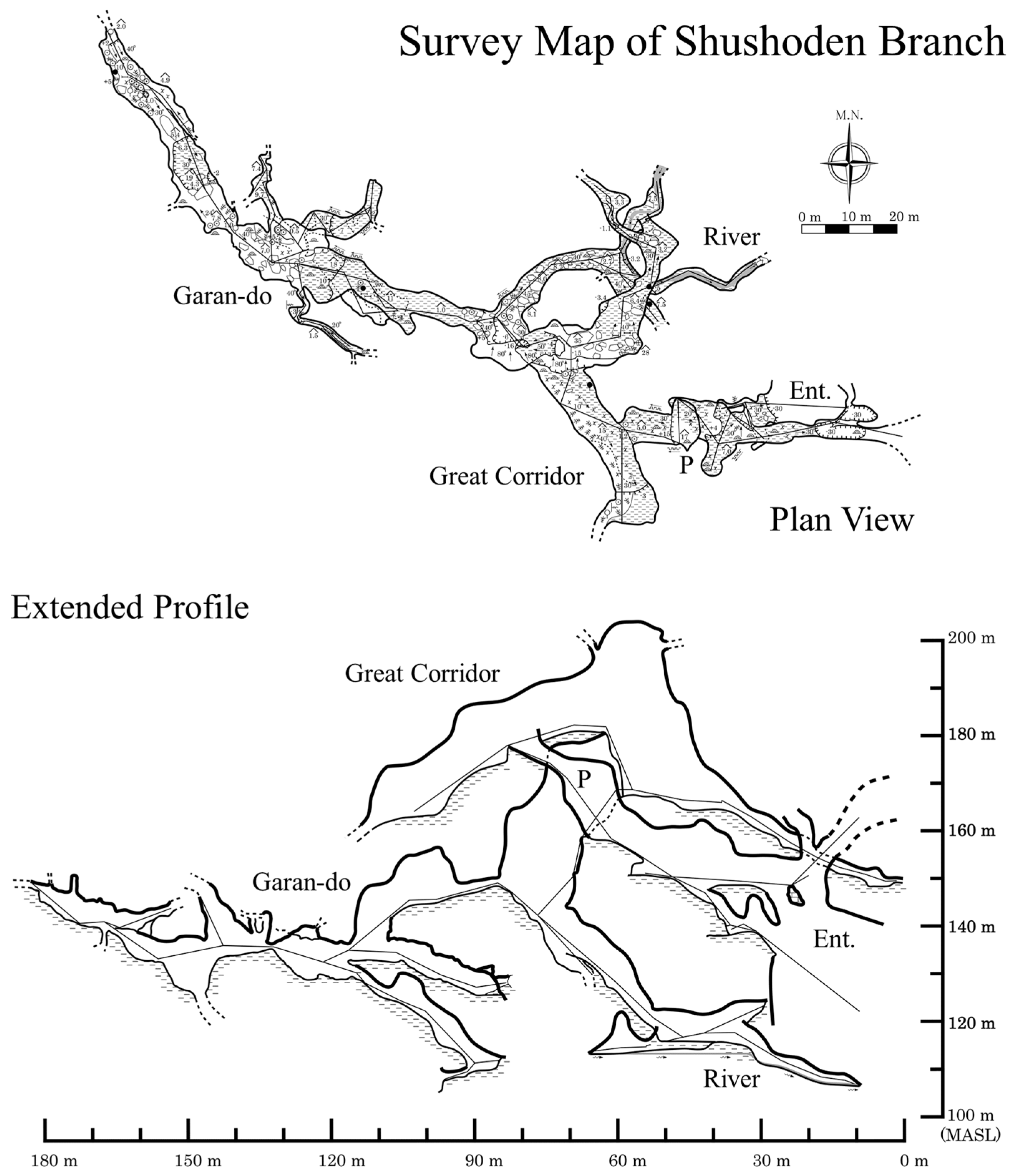
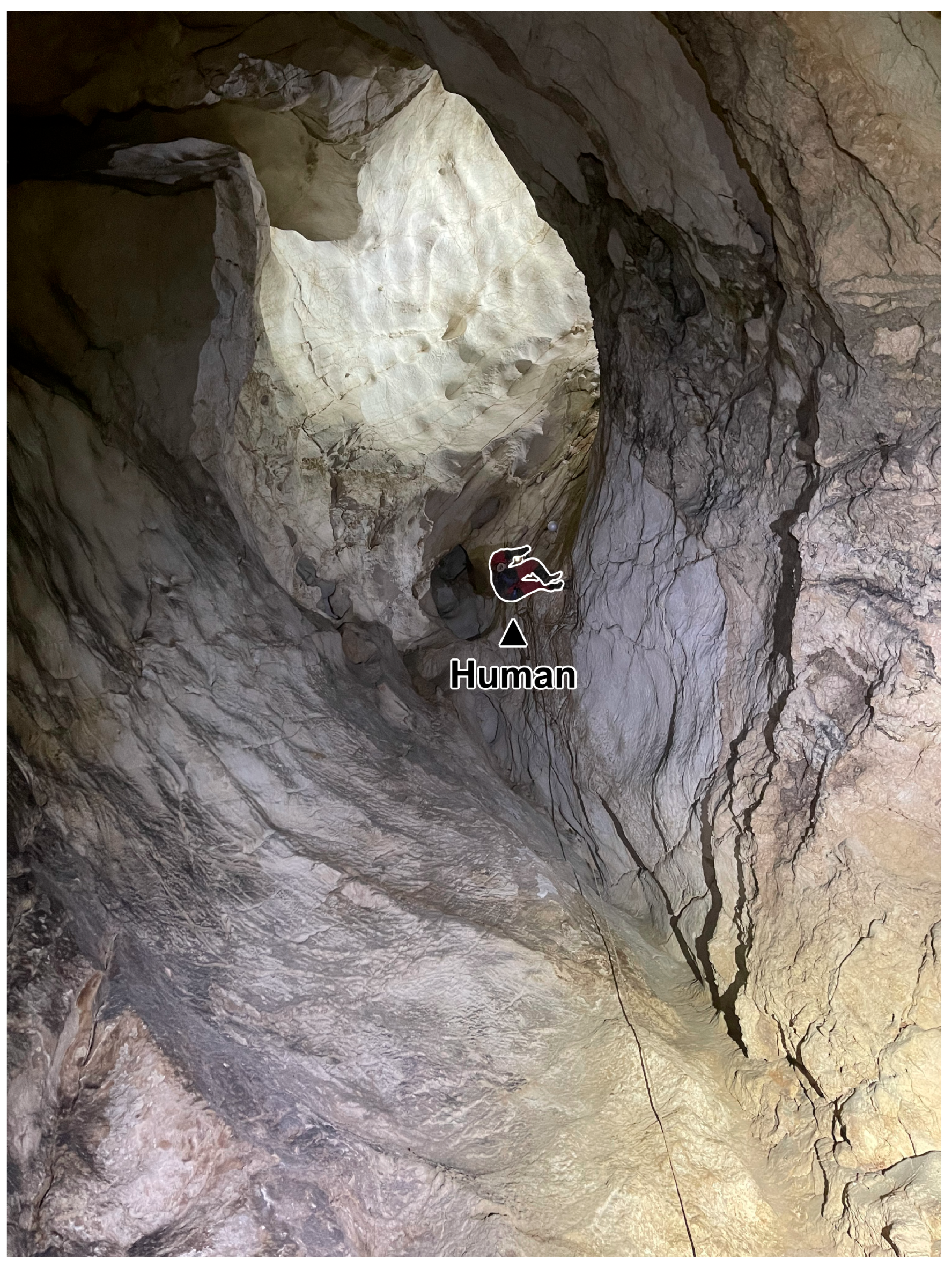
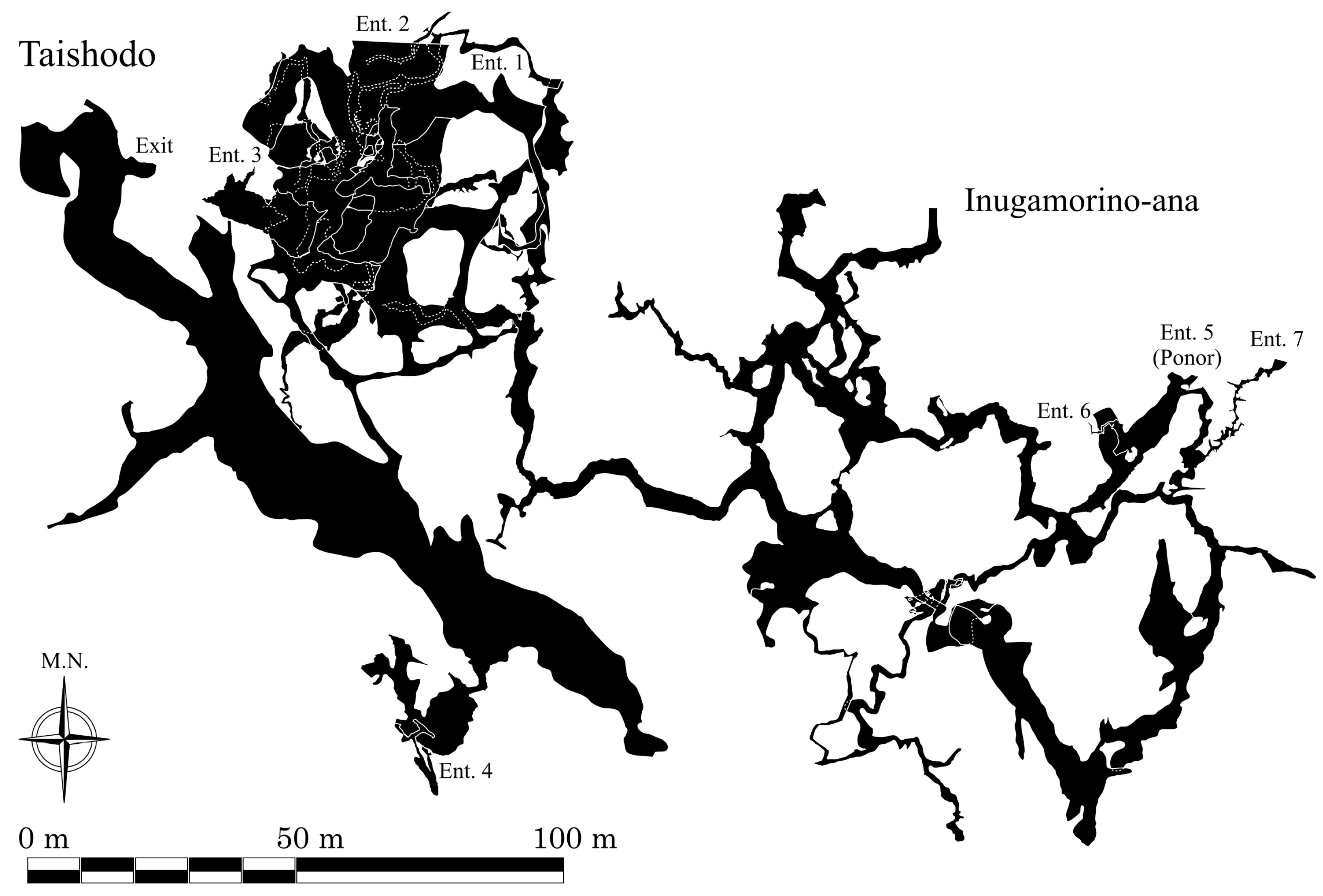
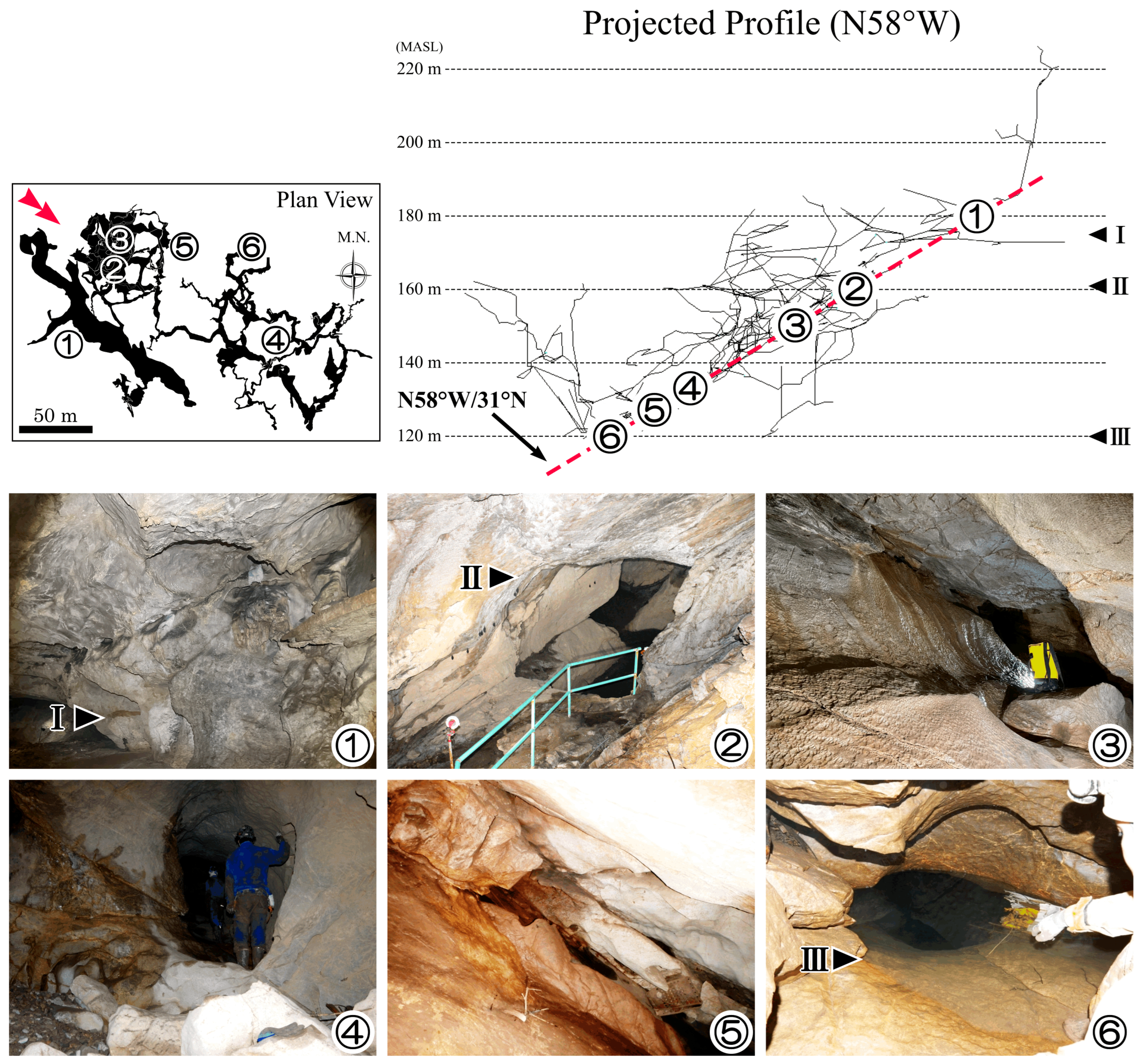


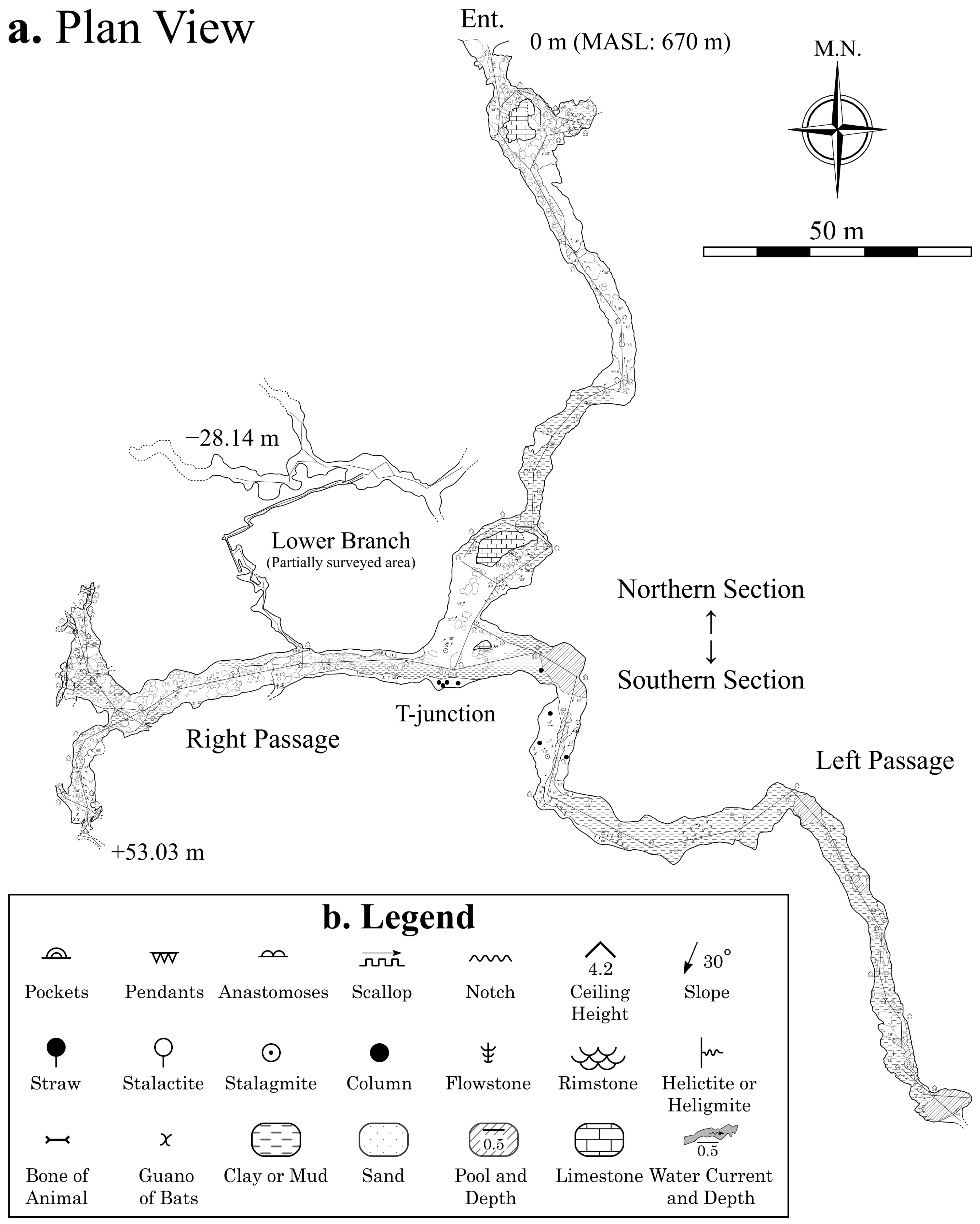

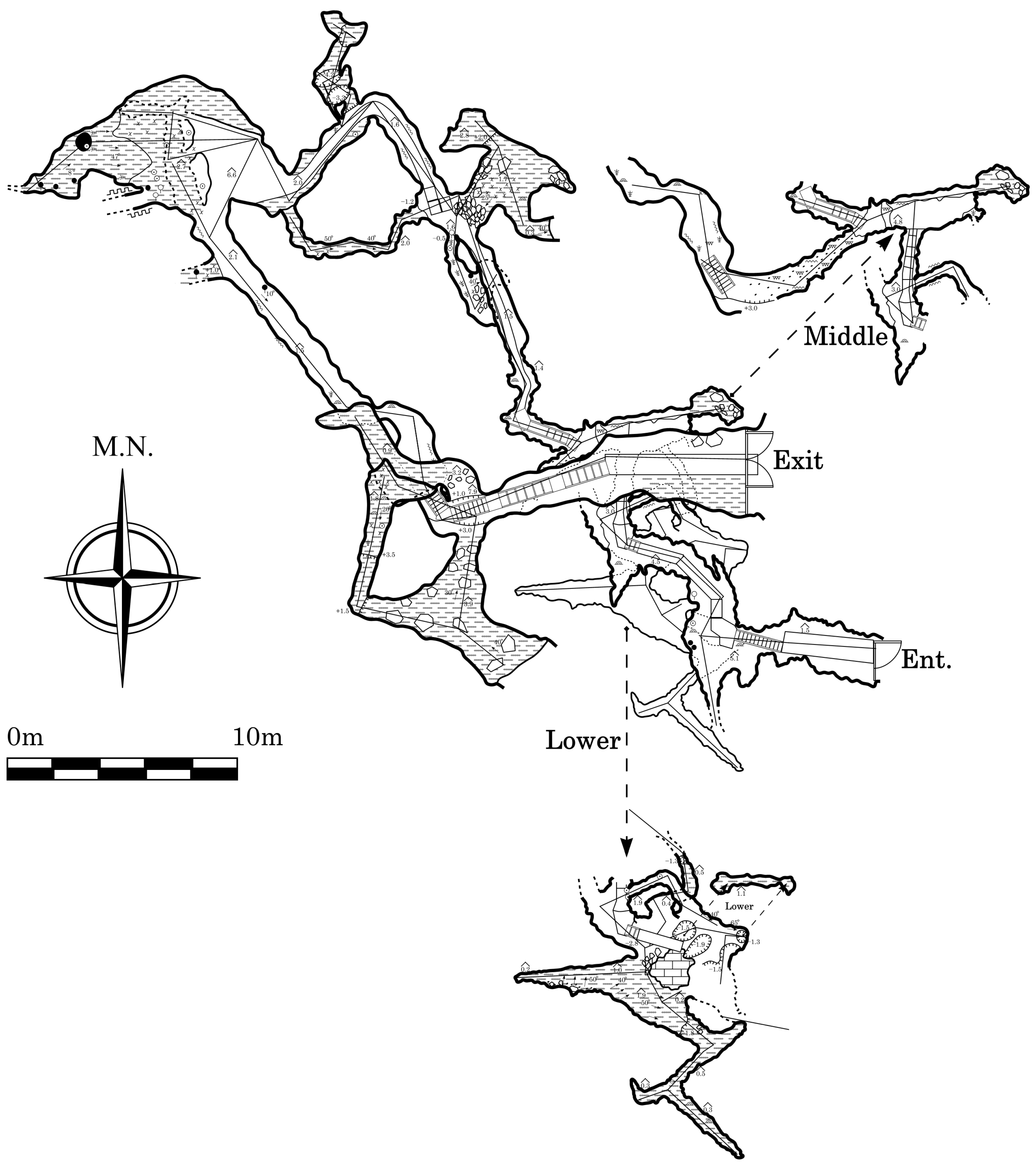
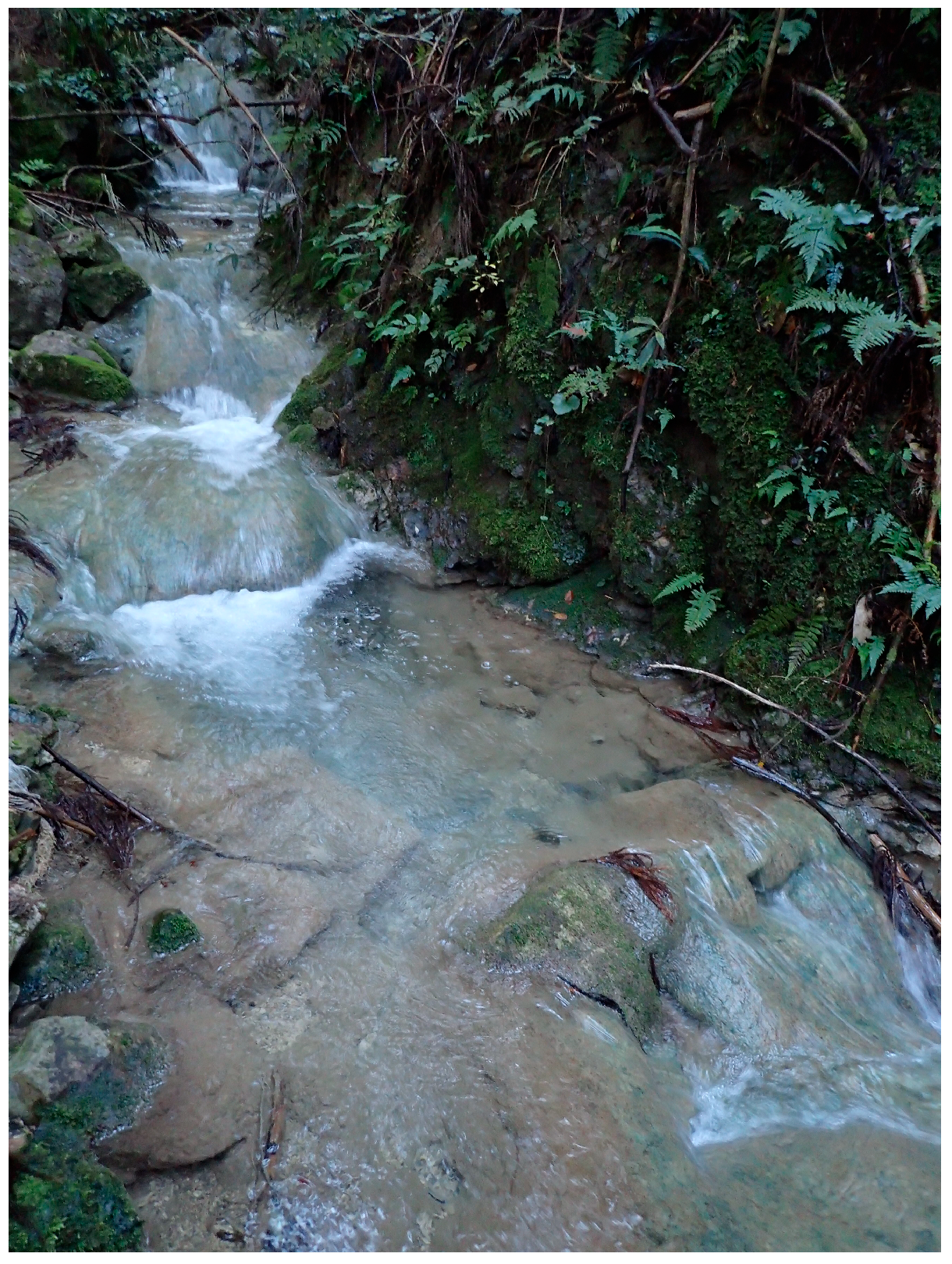

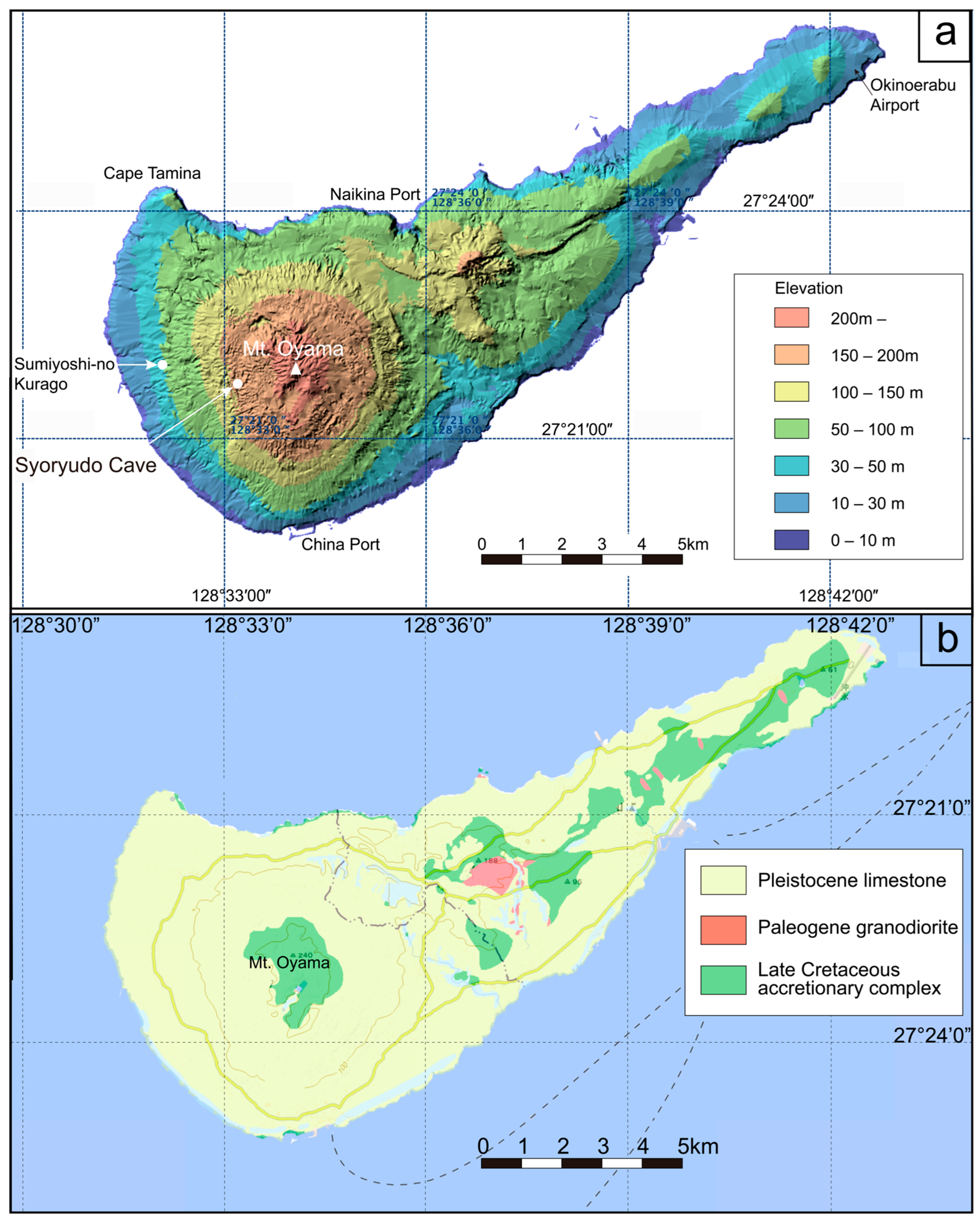
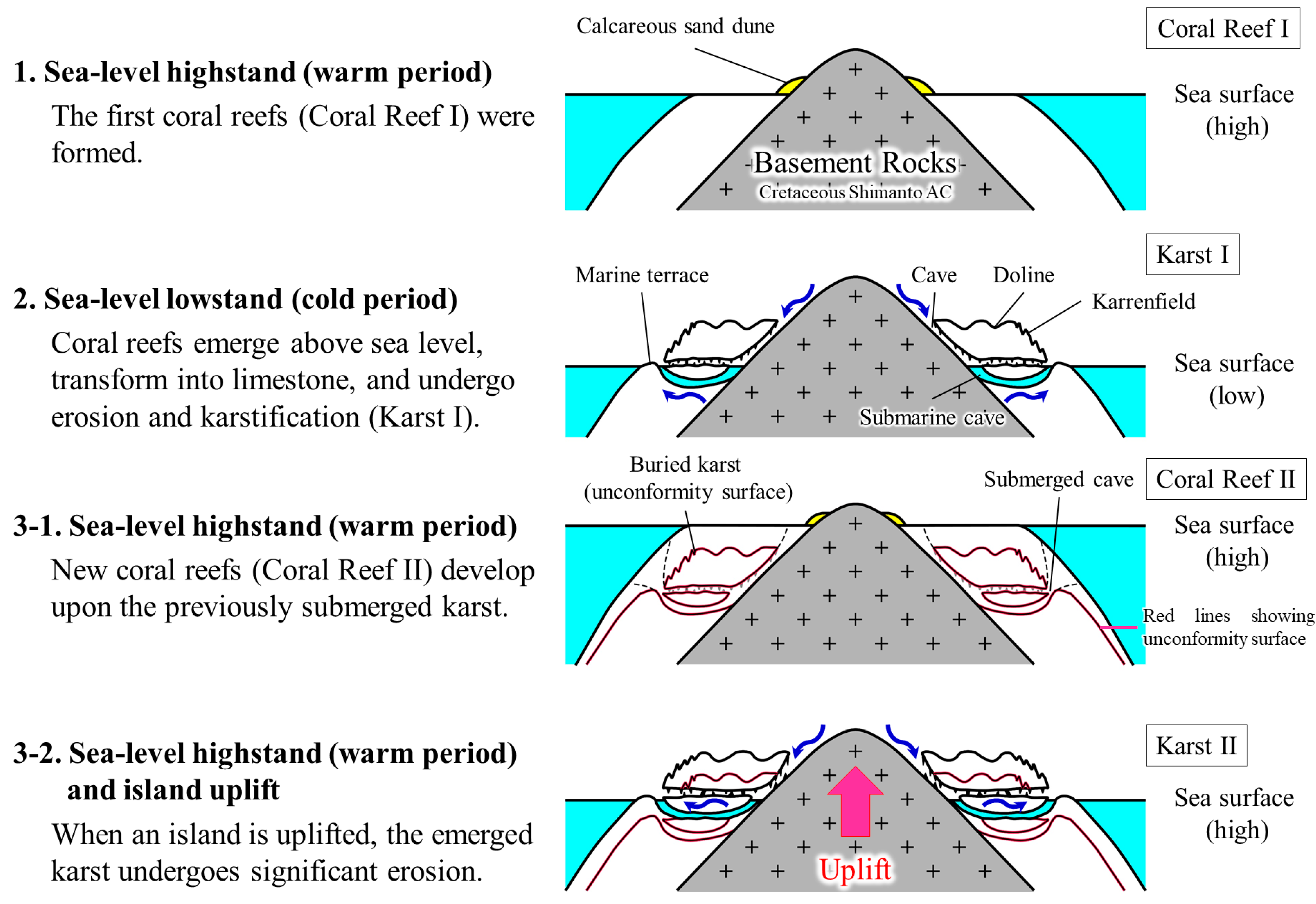
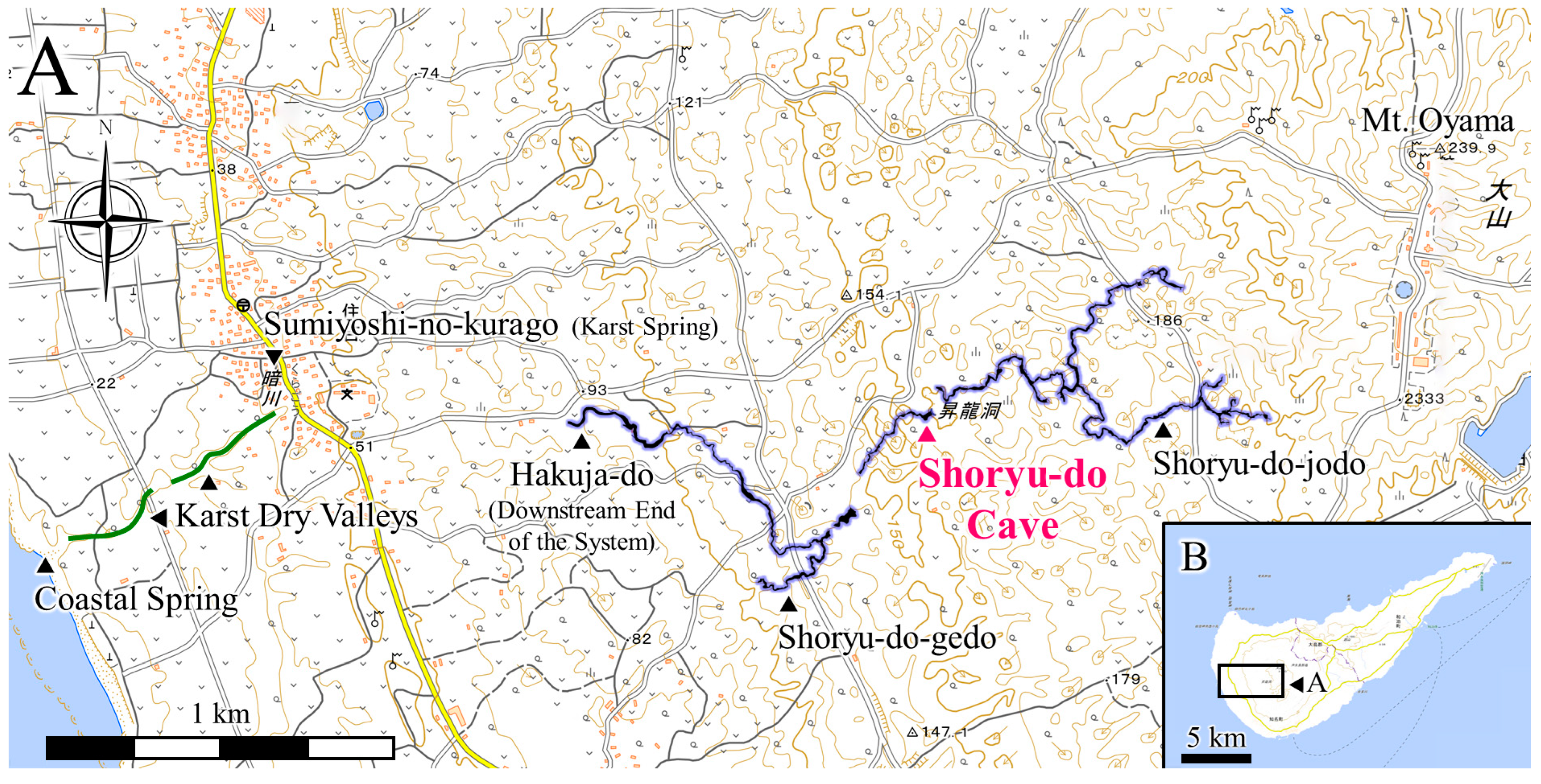
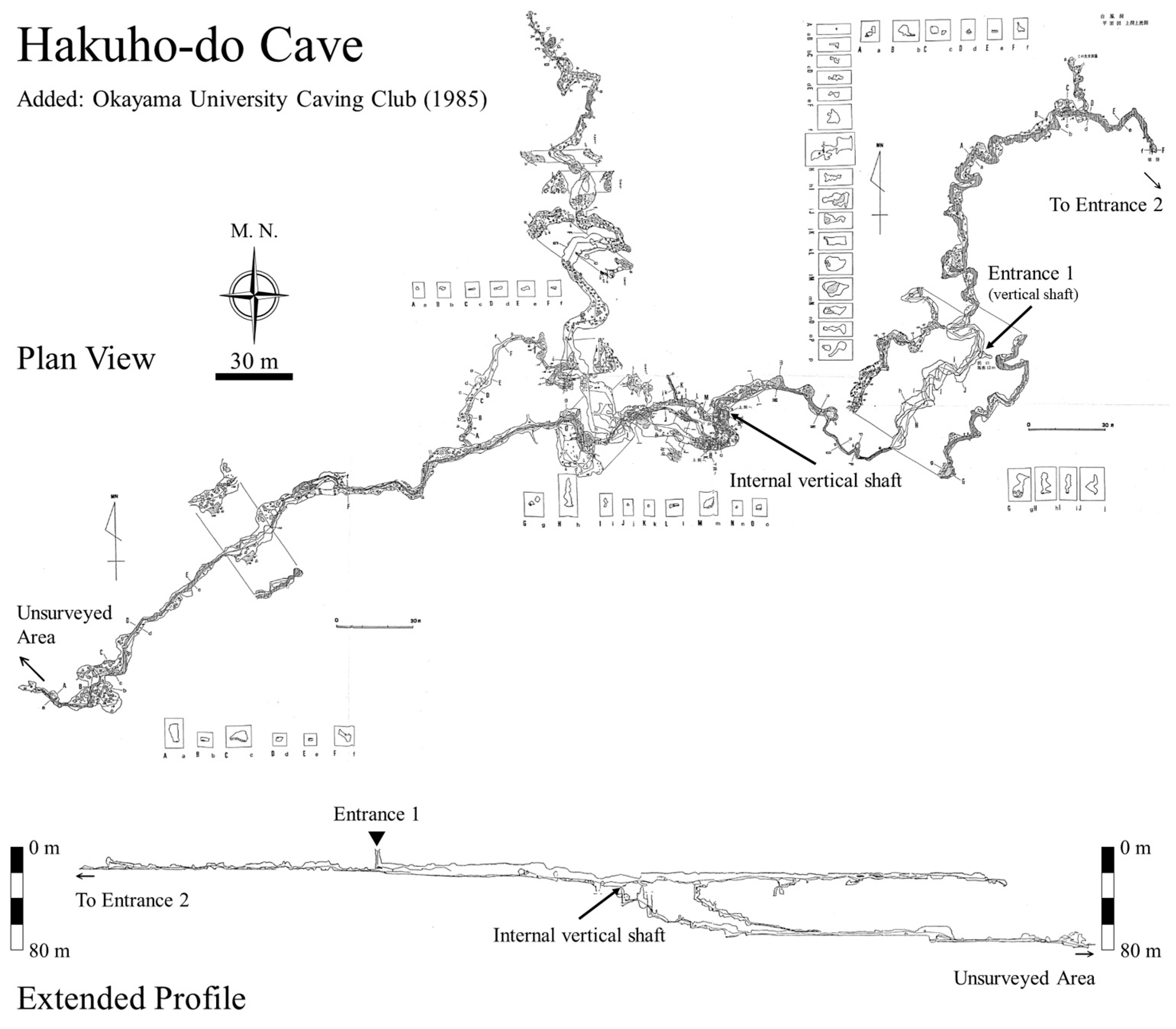
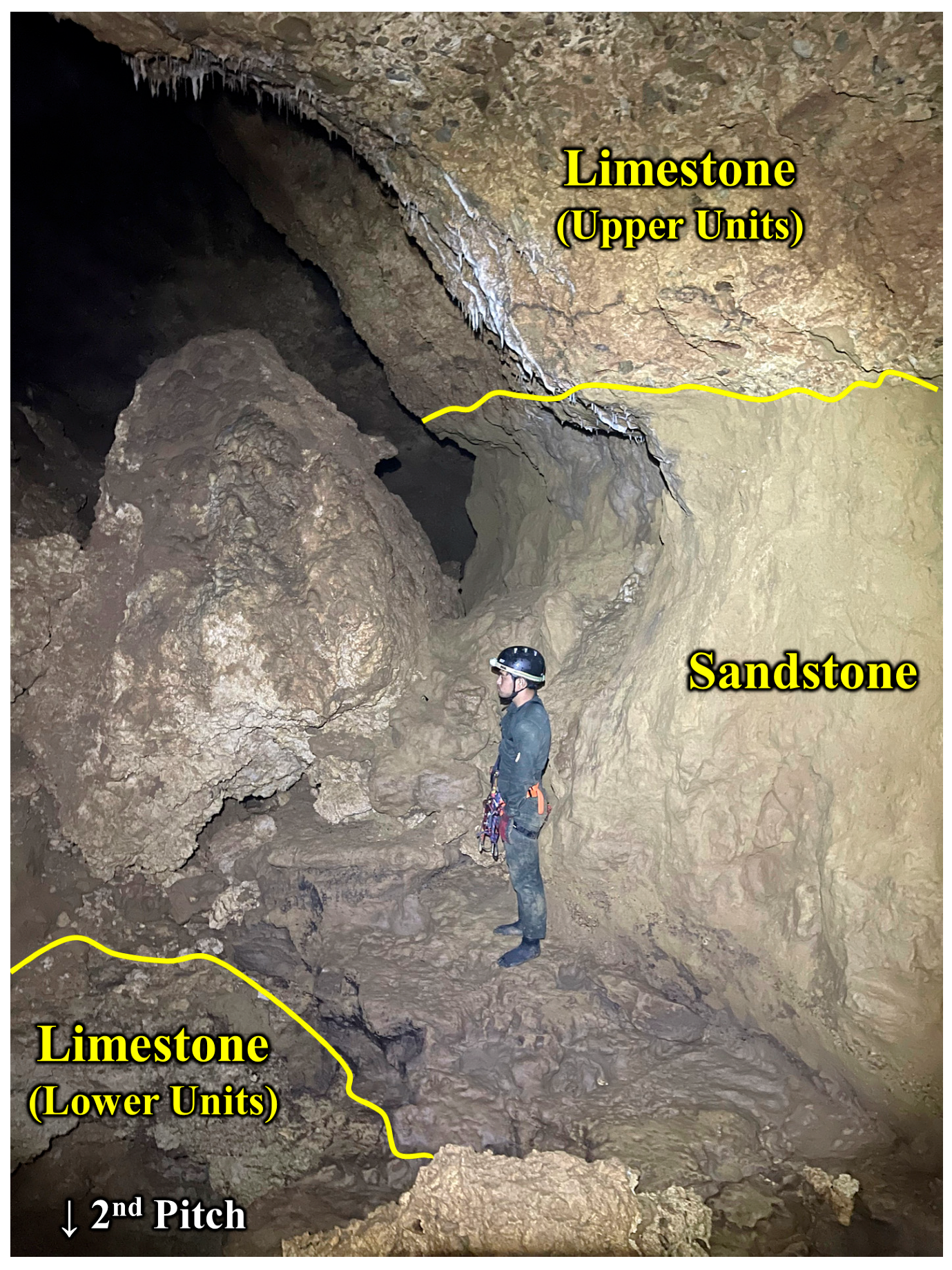
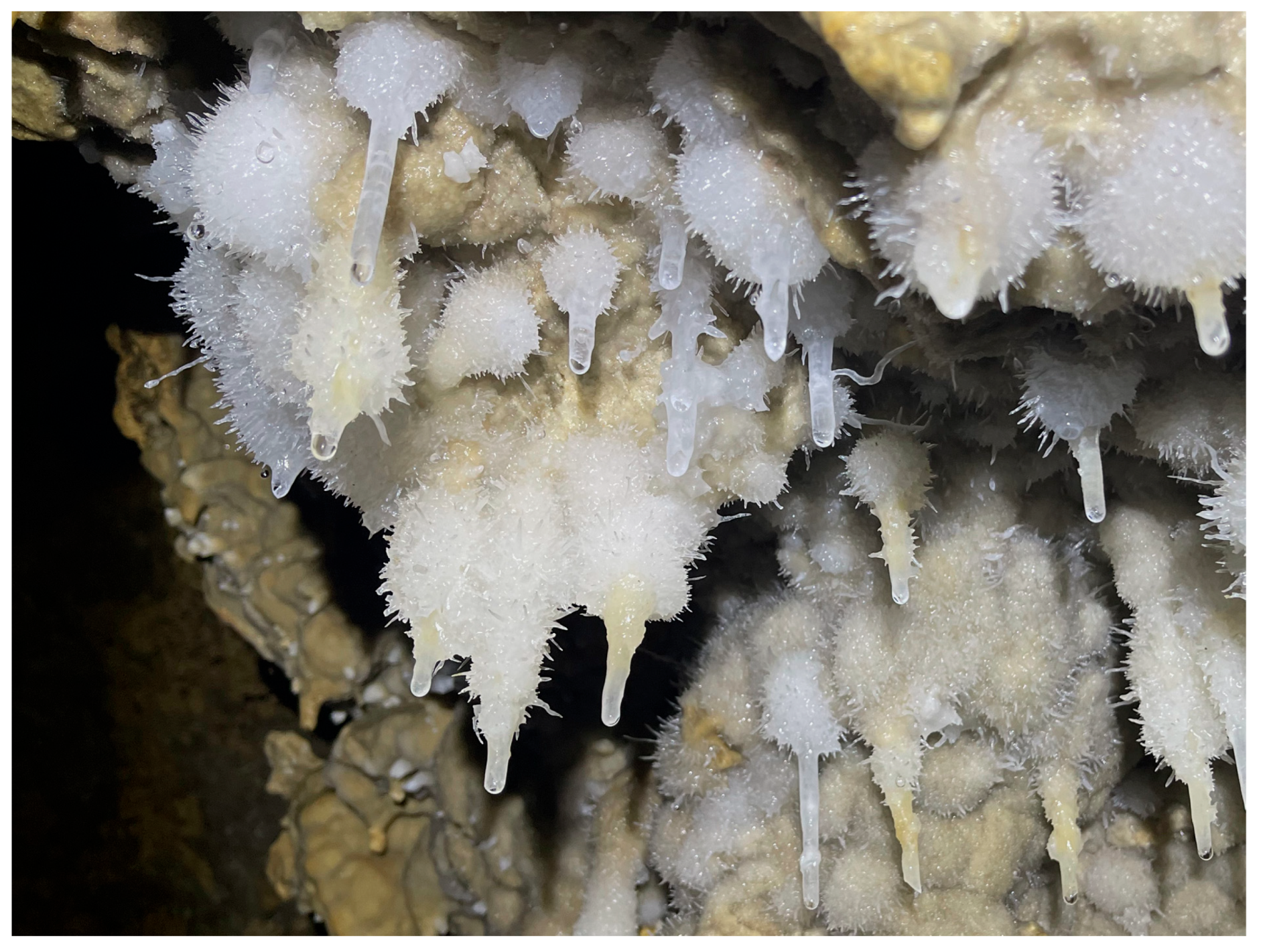
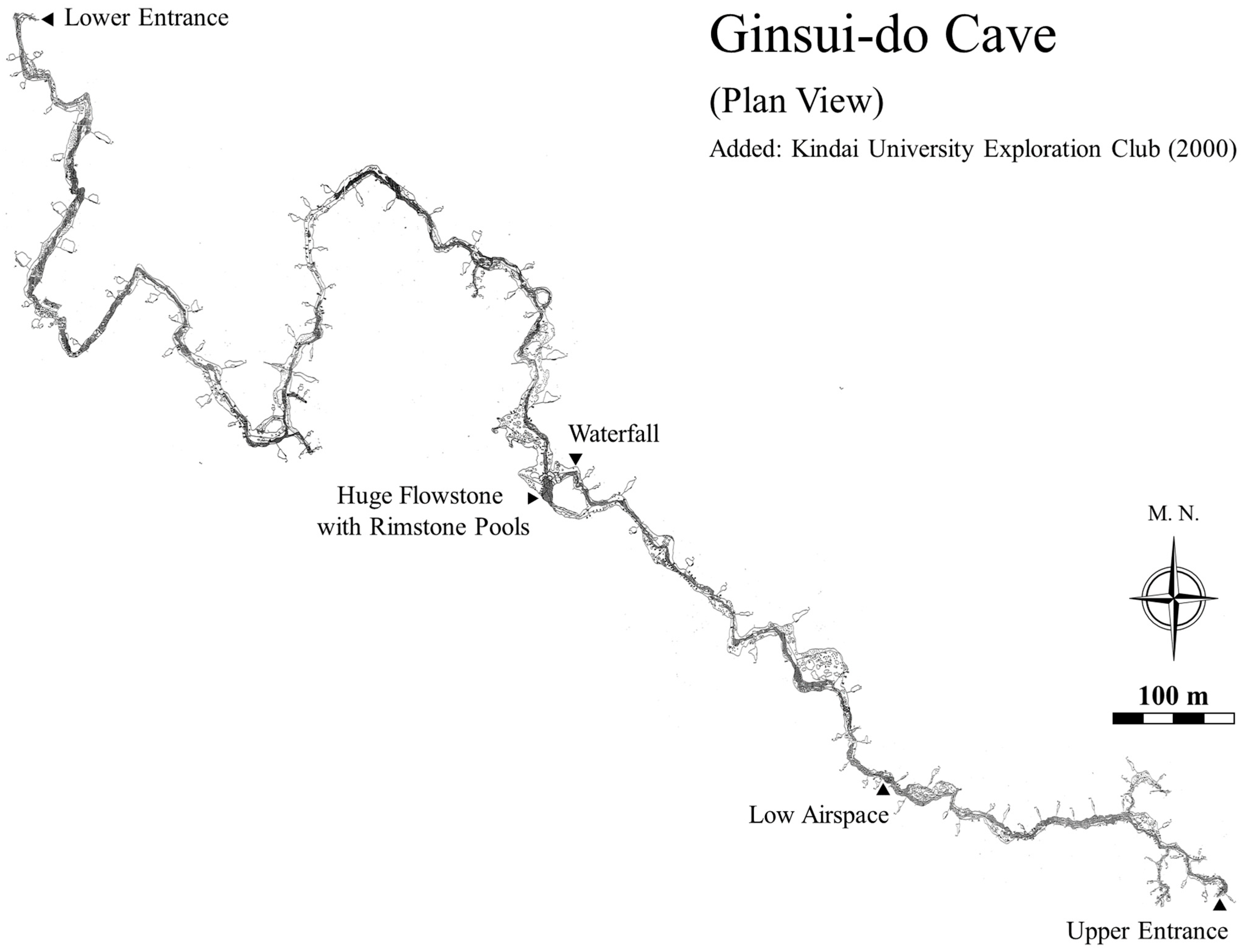
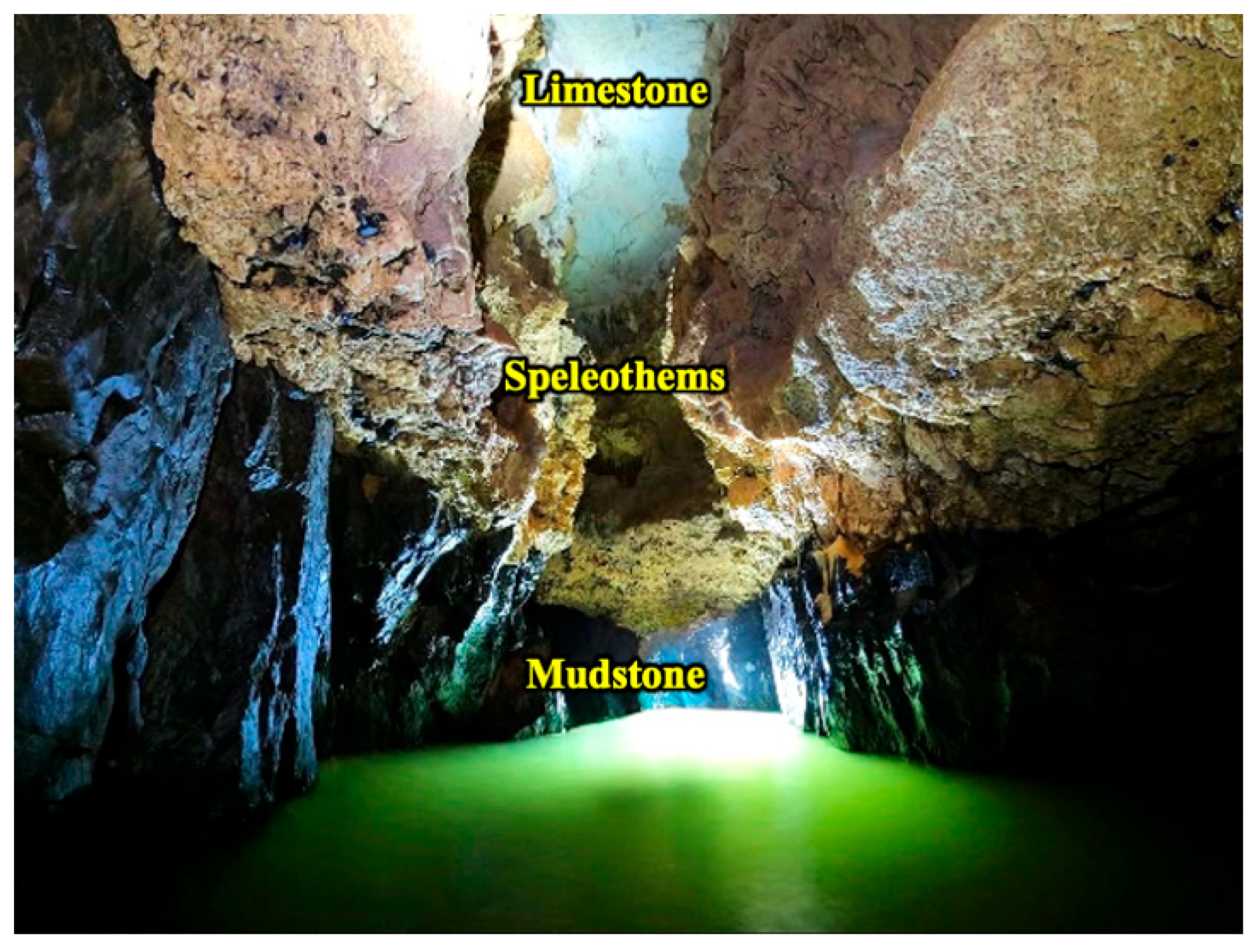
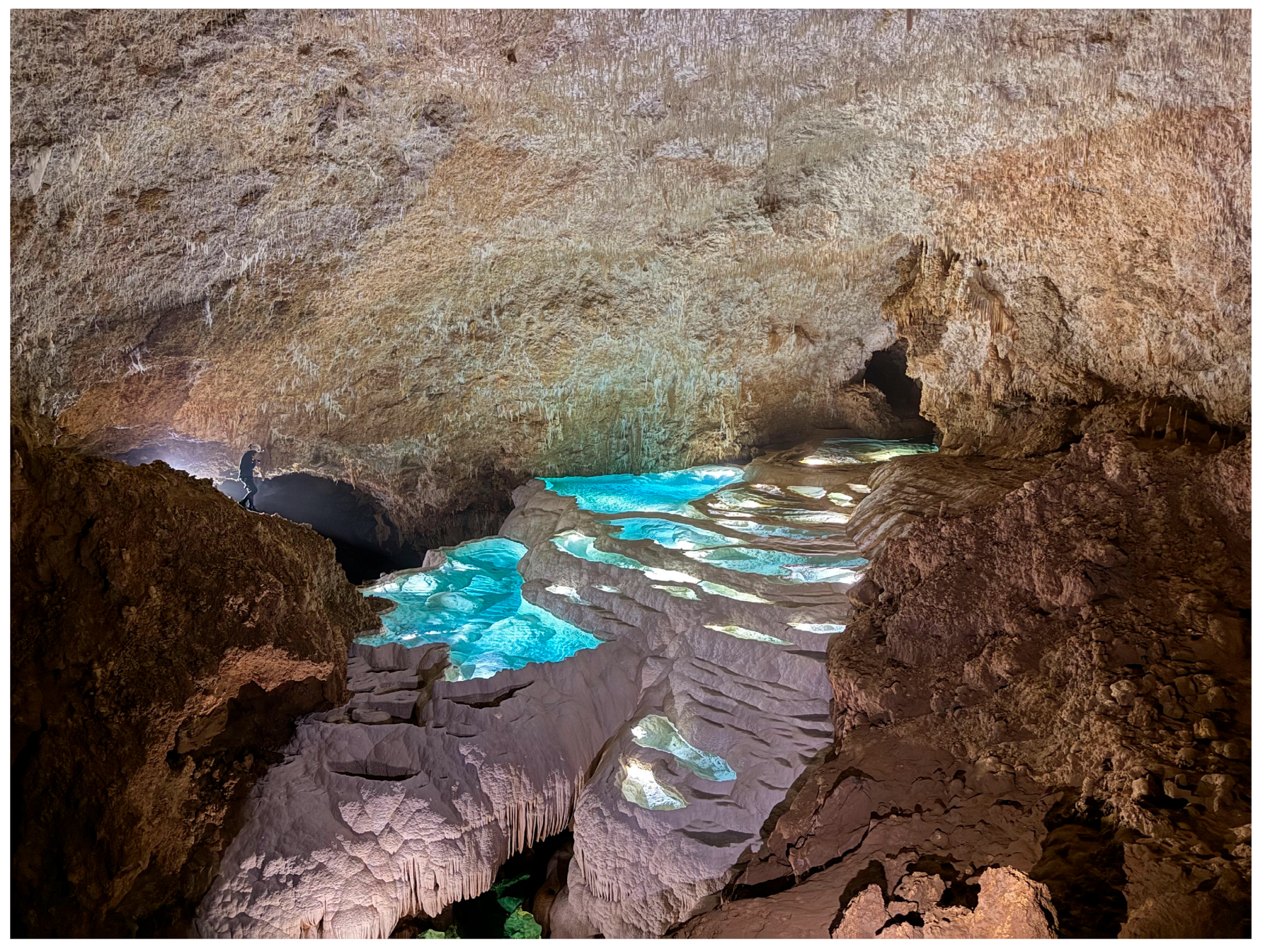
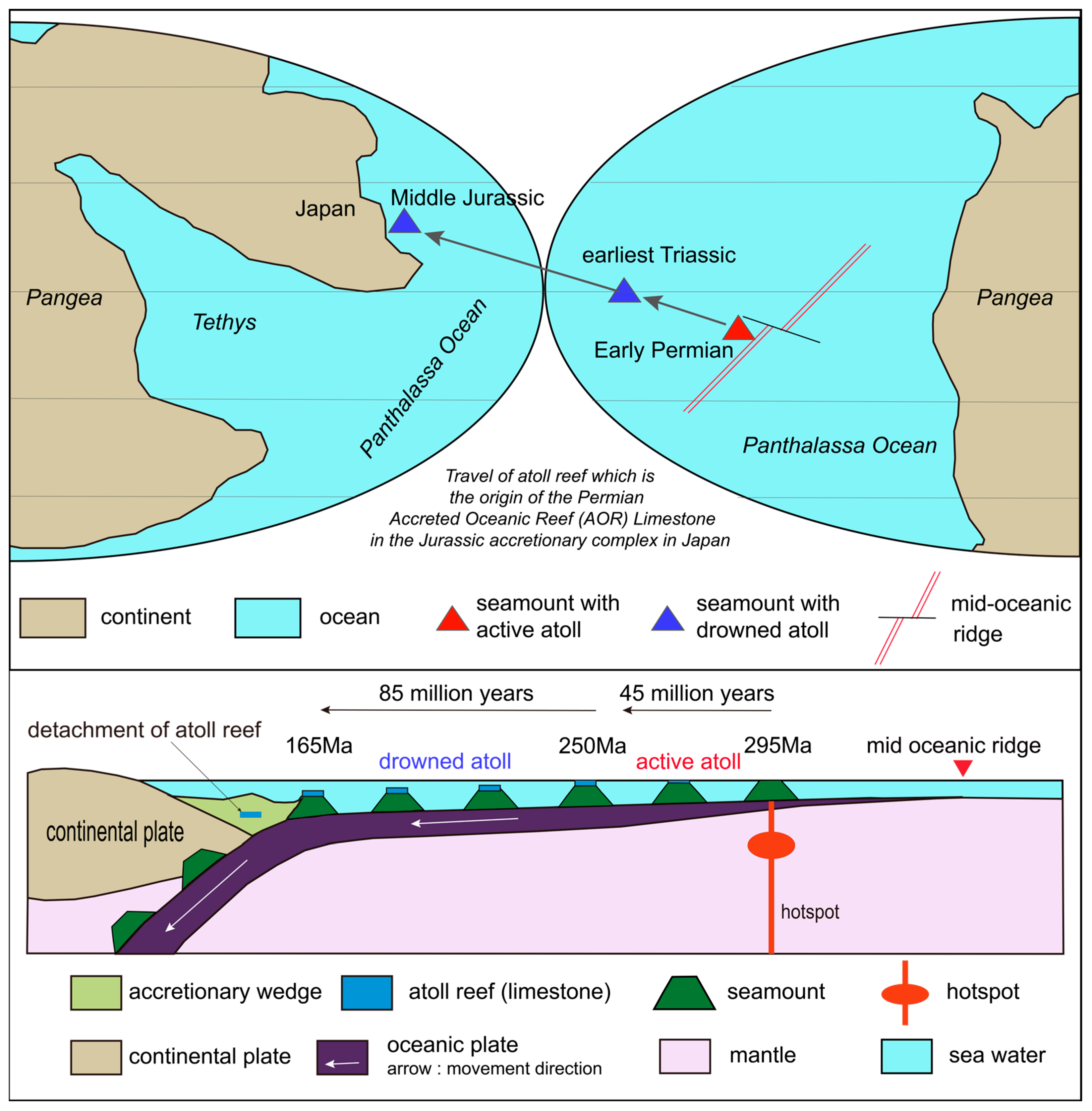

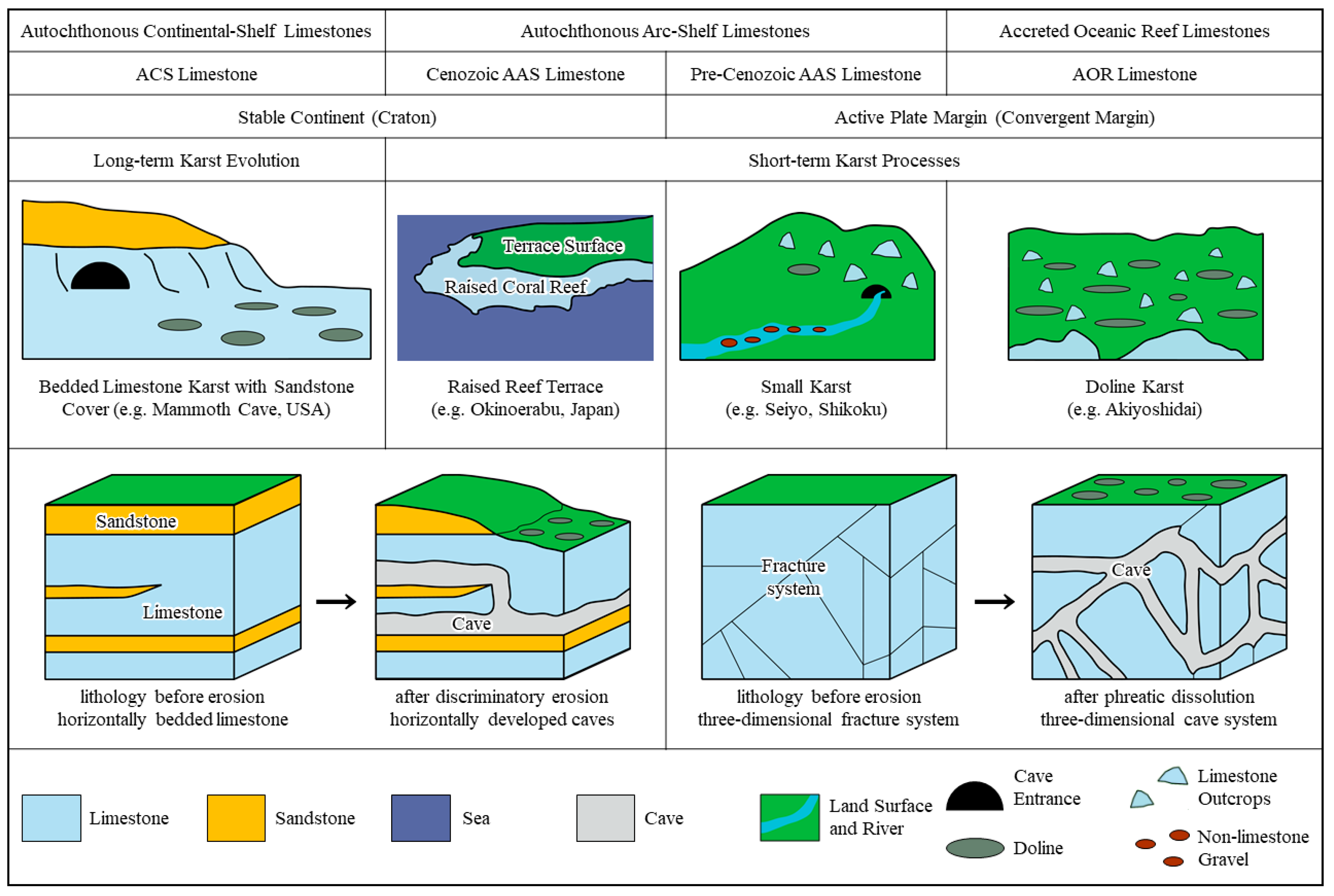
| No. | Complex | Geologic Belt | Limestone | Plateau or Mt. | Prefecture | Age | Major Caves |
|---|---|---|---|---|---|---|---|
| 1 | Permian Accretionary Complex | Akiyoshi belt | Hiraodai Limestone | Hiraodai | Fukuoka | Carboniferous to Permian | Senbutsu |
| 2 | Permian Accretionary Complex | Akiyoshi belt | Akiyoshi Limestone | Akiyoshidai | Yamaguchi | Carboniferous to Permian | Akiyoshido, Taishodo, Kagekiyo-ana |
| 3 | Permian Accretionary Complex | Akiyoshi belt | Taisyaku Limestone | Taisyakudai | Hiroshima | Carboniferous to Permian | Haku-un-do |
| 4 | Permian Accretionary Complex | Akiyoshi belt | Koyama-Nakamura Limestone | Ohgadai | Okayama | Carboniferous to Permian | Iwaya-do |
| 5 | Permian Accretionary Complex | Akiyoshibelt | Atetsu Limestone | Atetsudai | Okayama | Carboniferous to Permian | Ikura-do, Maki-do |
| 6 | Permian Accretionary Complex | Akiyoshi belt | Ōmi Limestone | Kurohime-Myojo | Niigata | Carboniferous to Permian | Byakuren-do, Ōmi-Senri-do, Fukugakuchi |
| 7 | Permian Accretionary Complex | Kurosegawa belt | Ōnogahara-Torigatayama Limestone | Shikoku Karst | Ehime-Kochi | Carboniferous to Permian | Rakan-ana |
| 8 | Jurassic Accretionary Complex | Tamba belt | Limestone of Shizushi Cave | Kyoto | Permian | Shizushi | |
| 9 | Jurassic Accretionary Complex | Minobelt | Ryozen Limestones | Ryozenzan | Gifu-Mie | Permian | Sekigahara |
| 10 | Jurassic Accretionary Complex | Mino belt | Ibukiyama Limestone | Ibukiyama | Gifu | Permian | not found |
| 11 | Jurassic Accretionary Complex | Mino belt | Funafuseyama Limestone | Funafuseyama | Gifu | Permian | not found |
| 12 | Jurassic Accretionary Complex | Mino belt | Akuda Limestone | Gifu | Permian | Otaki, Jomon | |
| 13 | Jurassic Accretionary Complex | Mino belt | Akasaka Limestone | Kinshozan | Gifu | Permian | not found |
| 14 | Jurassic Accretionary Complex | Mino belt | Limestone of Hida Great Cave | Gifu | Permian | Hida Great | |
| 15 | Jurassic Accretionary Complex | Ashio belt | Kuzu-u Limestone | Tochigi | Permian | Izuru, Utsuno | |
| 16 | Jurassic Accretionary Complex | Ashio belt | Limestone of Odaira Cave | Tochigi | Permian | Odaira | |
| 17 | Jurassic Accretionary Complex | Chichibu belt | Limestone of Ryugashi Cave | Shizuoka | Permian | Ryugashi-do | |
| 18 | Jurassic Accretionary Complex | Chichibu belt | Limestone of Ohtake Cave | Tokyo | Permian | Ohtake | |
| 19 | earlliest Cretaceous Accretionary Complex | Sambosan belt | Limestone of Konose Group | Kumamoto | Permian to Triassic | Kyusen-do, Konose | |
| 20 | earlliest Cretaceous Accretionary Complex | Sambosan belt | Kamura Limestone | Miyazaki | Permian to Triassic | not found | |
| 21 | earlliest Cretaceous Accretionary Complex | Sambosan belt | Tsukumi Limestone | Oita | Permian to Triassic | not found | |
| 22 | earlliest Cretaceous Accretionary Complex | Sambosan belt | Limestone of Ryuga Cave | Sambosan | Kochi | Permian to Triassic | Ryuga-do |
| 23 | earlliest Cretaceous Accretionary Complex | Sambosan belt | Limestone of Yasumori Cave | Ehime | Permian to Triassic | Yasumori-do | |
| 24 | earlliest Cretaceous Accretionary Complex | Sambosan belt | Limestone of Totsui Cave | Wakayama | Permian to Triassic | Totsui | |
| 25 | earlliest Cretaceous Accretionary Complex | Sambosan belt | Limestone of Menfudo Cave | Nara | Permian to Triassic | Menfudo | |
| 26 | earlliest Cretaceous Accretionary Complex | Sambosan belt | Bukozan Limestone | Bukozan | Saitama | Triassic | Hashidate |
| 27 | earlliest Cretaceous Accretionary Complex | North Chichibu belt | Akka Limestone | Iwate | Triassic | Ryusen-do, Akka-do | |
| 28 | earlliest Cretaceous Accretionary Complex | North Chichibu belt | Shiriyazaki Limestone | Aomori | Triassic | Shiriyazaki | |
| 29 | Cretaceous Accretionary Complex | Hidaka belt | Limestone of Tohma Formation | Hokkaido | Jurassic | Tohma | |
| 30 | Oceanic ridge on Philippines Sea Plate | South Borodino Island | Limestone and dolomeite of Daito Formation | Okinawa | Upper Miocene-Pliocene | Hoshino-do |
| No. | Sedimentary Environment | Stratigraphic Name | Lithology | Age | Geologic Belt or Area | Name of Caves | Prefecture | City, Town, Island |
|---|---|---|---|---|---|---|---|---|
| 31 | Paleozoic Continental Shelf | Nagaiwa Formation | Limestone | Carboniferous | South Kitakami belt | Rokkando | Iwate | Sumita Town |
| 32 | Paleozoic Continental Shelf | Kawauchi Formation | Limestone | Silurian | South Kitakami belt | Sekiya | Iwate | Ofunato City |
| 33 | Paleozoic Continental Shelf | Tobigamori Group | Limestone | Devonian to Carboniferous | South Kitakami belt | Yugendo | Iwate | Ichinoseki City |
| 34 | Paleozoic Continental Shelf | Takine Group | Limestone | Ordovician to Devonian | South Kitakami belt | Abukuma | Fukushima | Tamura City Takine Town |
| 35 | Paleozoic Continental Shelf | Takine Group | Limestone | Ordovician to Devonian | South Kitakami belt | Irimizu | Fukushima | |
| 36 | Jurassic Arc Shelf | Torinosu Limestone | Limestone | Jurassic | Chichibu belt | Anagami | Ehime | Seiyo City |
| 37 | Jurassic Arc Shelf | Torinosu Limestone | Limestone | Jurassic | Chichibu belt | Kuranuki-Shiraishi | Ehime | Seiyo City |
| 38 | Cenozoic Arc Shelf | Kakinoura Formation | Sandy/Algae Limestone | Oligocene | Kyushu Island | Nanatsugama | Nagasaki | Saikai City |
| 39 | Cenozoic Arc Shelf | Nakatonbetsu Formation | Fossil Shell Limestone | Pliocene | Hokkaido Island | Nakatonbetsu | Hokkaido | Nakatonbetsu Town |
| 40 | Cenozoic Arc Shelf | Ryukyu Group | Coral Limestone | Pleistocene | Ryukyu Islands | Shoryudo | Kagoshima | Okinoerabu Island |
| 41 | Cenozoic Arc Shelf | Ryukyu Group | Reef Limestone | Pleistocene | Ryukyu Islands | Akasaki | Kagoshima | Yoron Island |
| 42 | Cenozoic Arc Shelf | Ryukyu Group | Clastic Limestone | Pleistocene | Ryukyu Islands | Gyokusendo | Okinawa | Okinawa Main Island |
| 43 | Cenozoic Arc Shelf | Ryukyu Group | Coral Limestone | Pleistocene | Ryukyu Islands | Ishigakijima | Okinawa | Ishigaki Island |
| Region (Limestone) | Limestone Type | Lithology | Fracture System | Karst Features | Cave Features | Groundwater System |
|---|---|---|---|---|---|---|
| Akiyoshidai (Akiyoshi Limestone) | AOR | Massive, non-bedded, high-purity | 3-dimensional fracture system | Doline karst on plateau, fluvial karst plains at the foot of margins | 3-dimensional caves controlled by fracture system, originating from bathyphreatic caves | Extensive groundwater network, conduits formed by phreatic caves |
| Seiyo (Shikoku) (Torinosu Limestone) | AAS | Small lens-shaped bodies within sandstone and mudstone strata | 3-dimensional fracture system | Many swallow holes and karst springs in mountains | 3-dimensional caves controlled by fractures and geological boundaries | Small groundwater systems confined to individual limestone bodies |
| Okinoerabu Island (Ryukyu Limestone) | AAS | Well-bedded with interbedded terrestrial clastic layers | Almost absent | Numerous dolines and karst dry valleys on emergent coral-reef limestone | Planar Subterranean river cave systems developed along geological boundaries | Radially developed along island slopes; some connect to the sea via submarine caves |
Disclaimer/Publisher’s Note: The statements, opinions and data contained in all publications are solely those of the individual author(s) and contributor(s) and not of MDPI and/or the editor(s). MDPI and/or the editor(s) disclaim responsibility for any injury to people or property resulting from any ideas, methods, instructions or products referred to in the content. |
© 2025 by the authors. Licensee MDPI, Basel, Switzerland. This article is an open access article distributed under the terms and conditions of the Creative Commons Attribution (CC BY) license (https://creativecommons.org/licenses/by/4.0/).
Share and Cite
Wakita, K.; Murakami, T.; Tsuji, T.; Urata, K. Geological and Geographical Characteristics of Limestone and Karst Landforms in Japan: Insights from Akiyoshidai, Seiyo (Shikoku), and Okinoerabu Island. Geosciences 2025, 15, 393. https://doi.org/10.3390/geosciences15100393
Wakita K, Murakami T, Tsuji T, Urata K. Geological and Geographical Characteristics of Limestone and Karst Landforms in Japan: Insights from Akiyoshidai, Seiyo (Shikoku), and Okinoerabu Island. Geosciences. 2025; 15(10):393. https://doi.org/10.3390/geosciences15100393
Chicago/Turabian StyleWakita, Koji, Takashi Murakami, Tomohiro Tsuji, and Kensaku Urata. 2025. "Geological and Geographical Characteristics of Limestone and Karst Landforms in Japan: Insights from Akiyoshidai, Seiyo (Shikoku), and Okinoerabu Island" Geosciences 15, no. 10: 393. https://doi.org/10.3390/geosciences15100393
APA StyleWakita, K., Murakami, T., Tsuji, T., & Urata, K. (2025). Geological and Geographical Characteristics of Limestone and Karst Landforms in Japan: Insights from Akiyoshidai, Seiyo (Shikoku), and Okinoerabu Island. Geosciences, 15(10), 393. https://doi.org/10.3390/geosciences15100393






